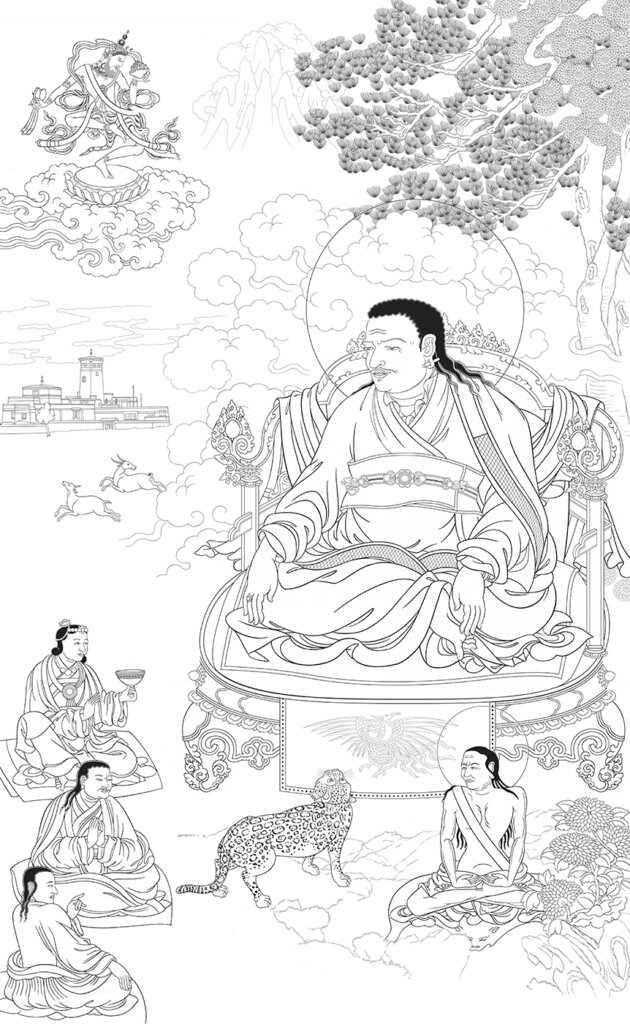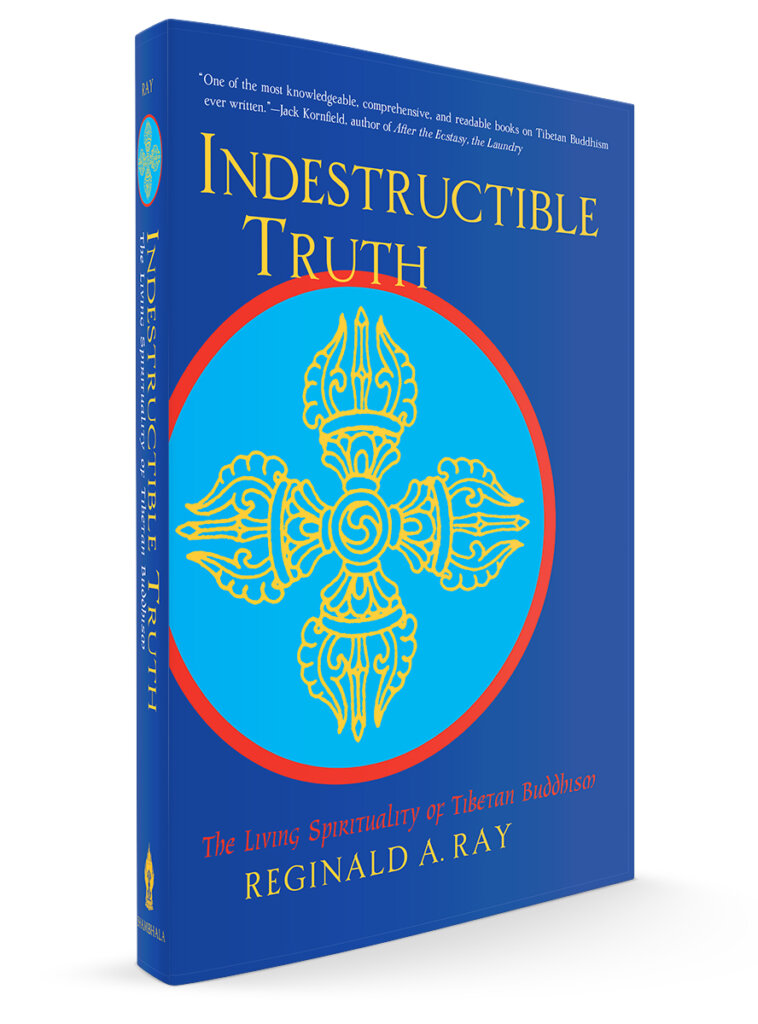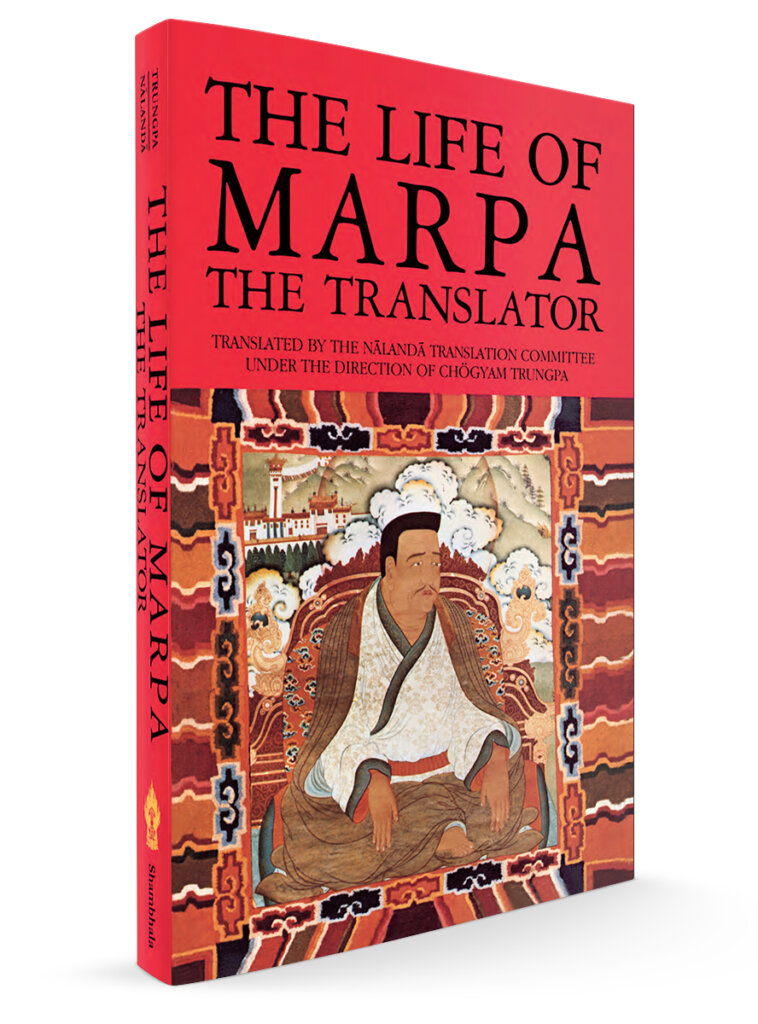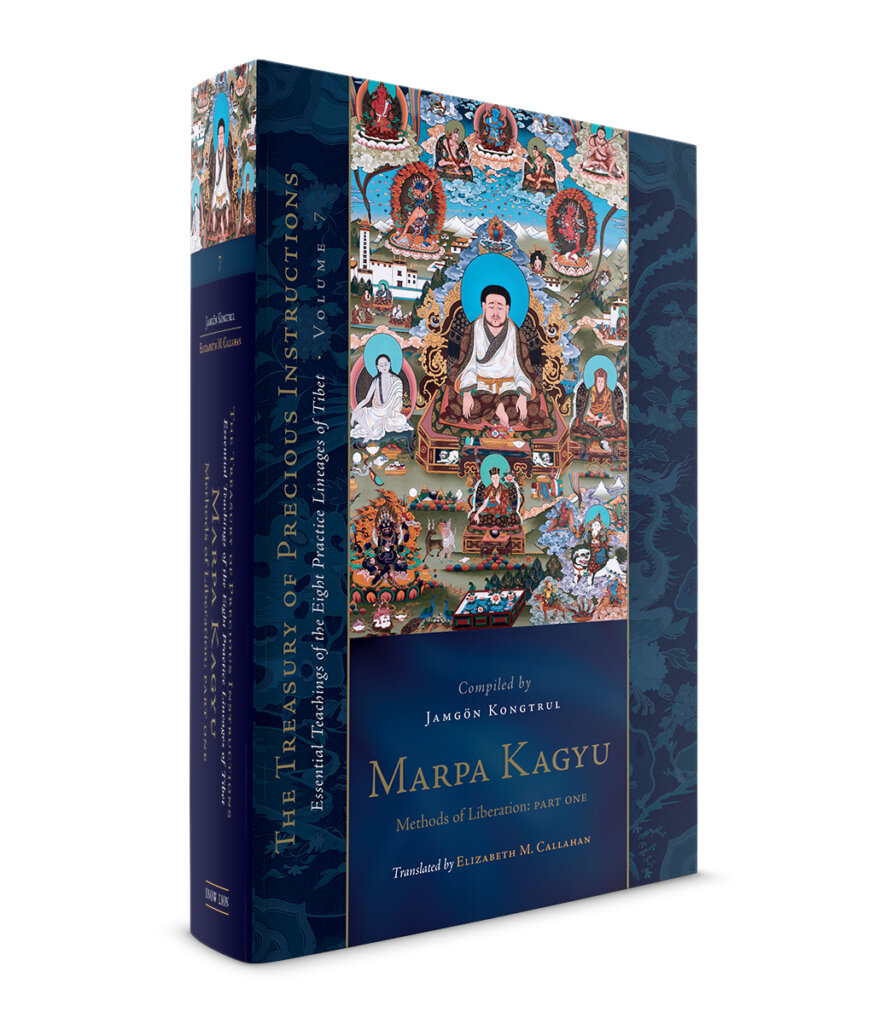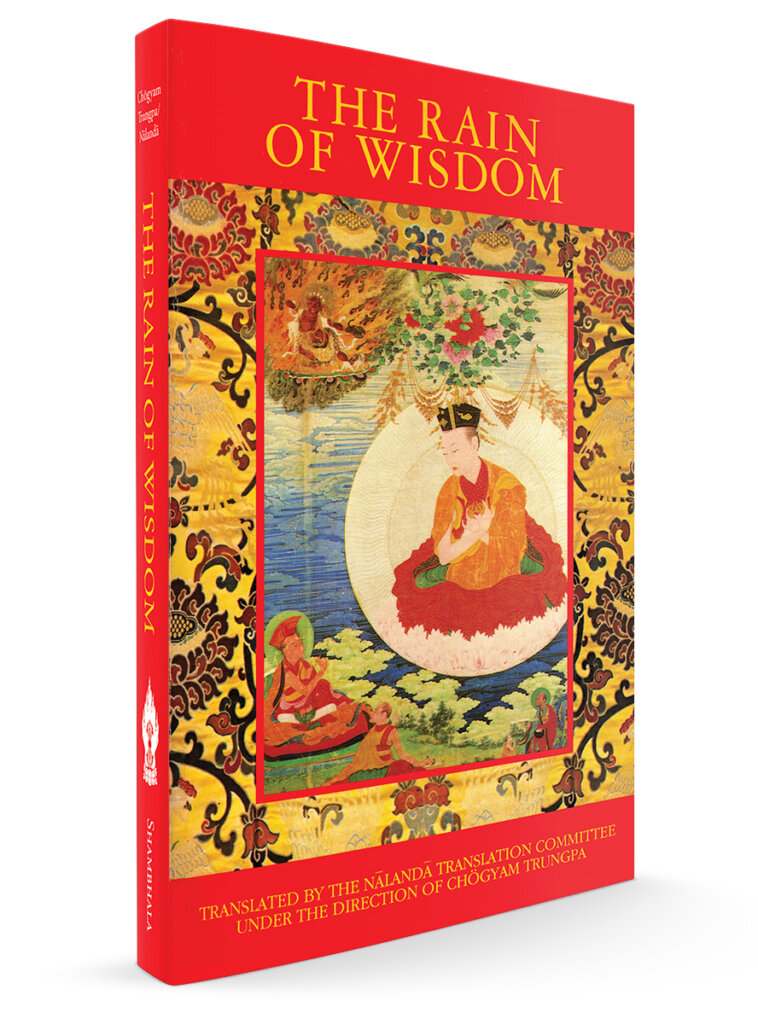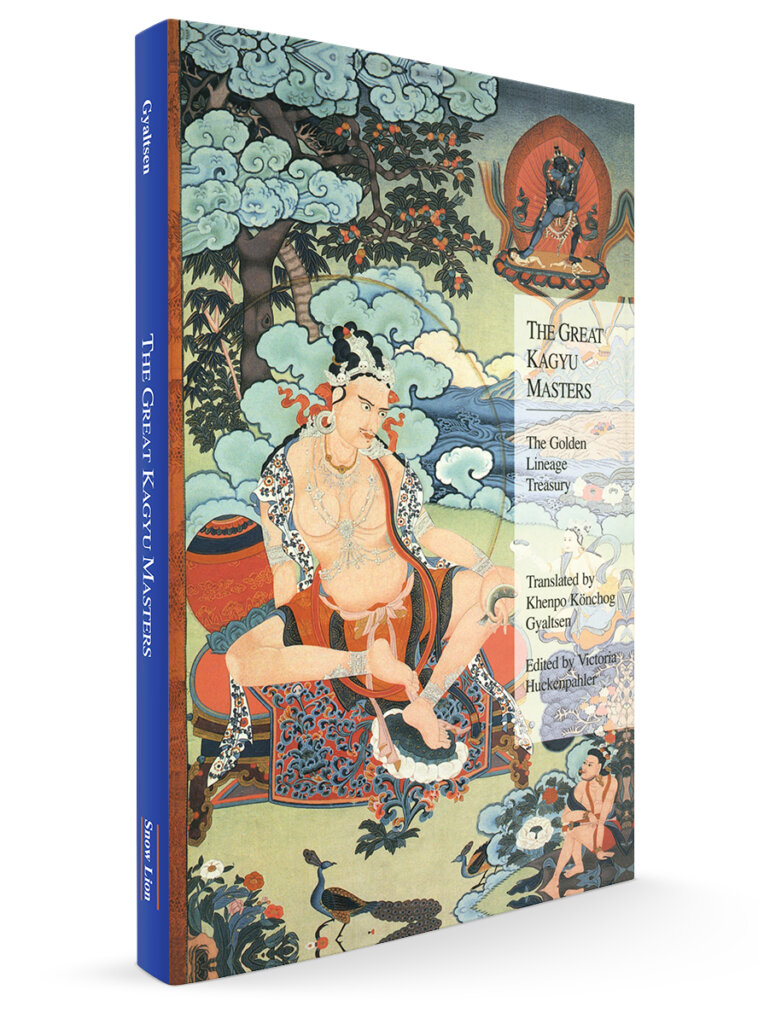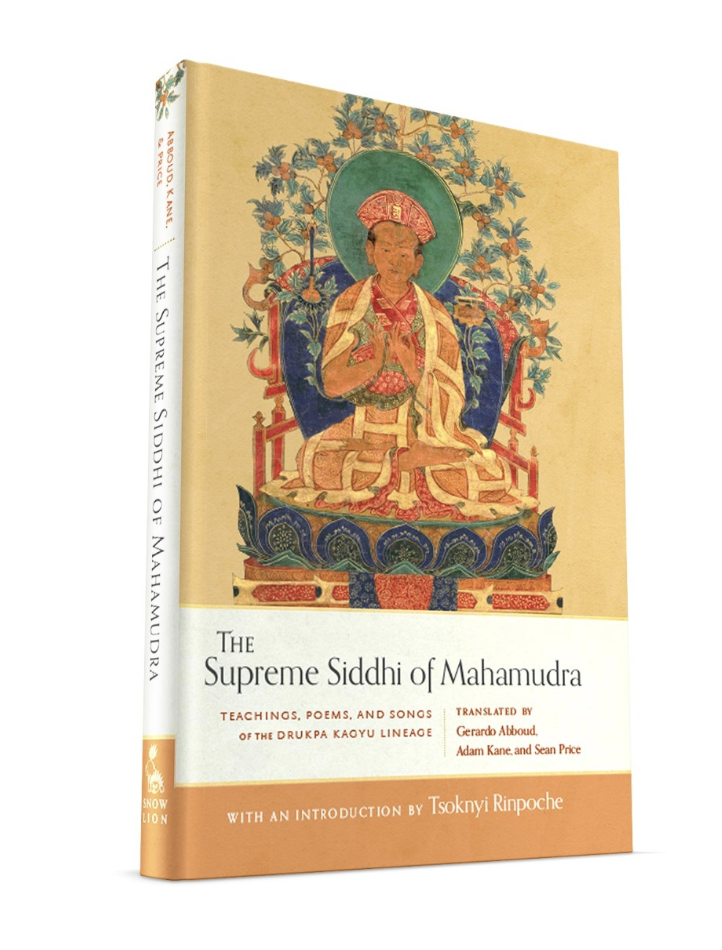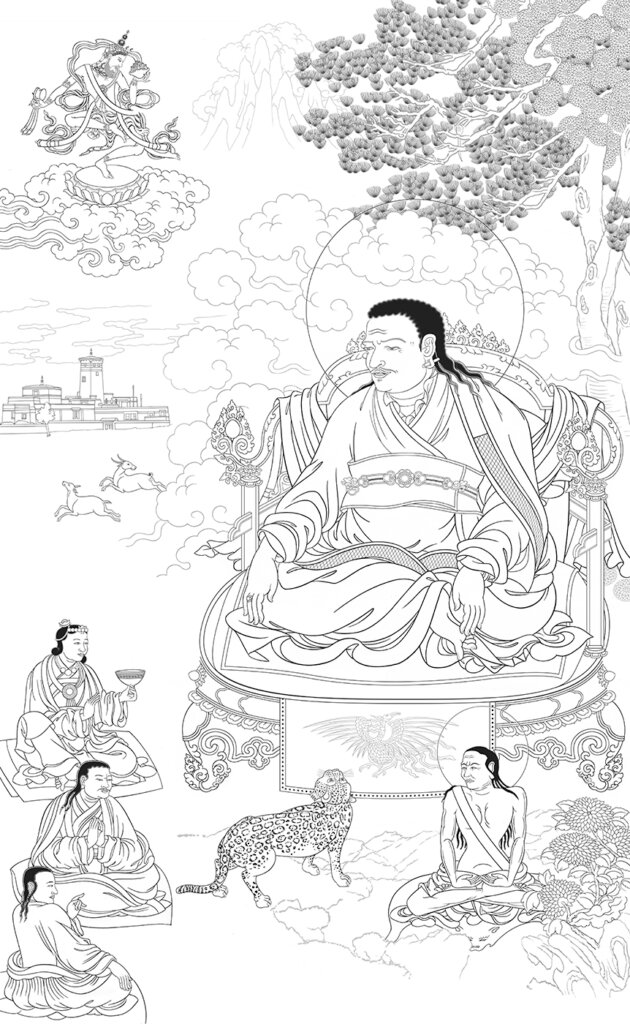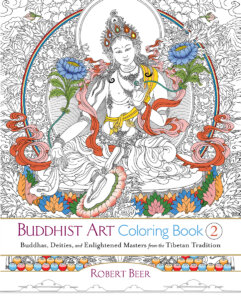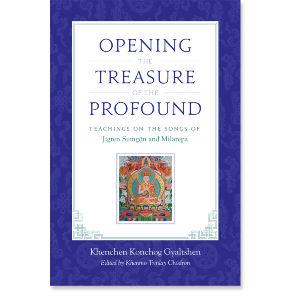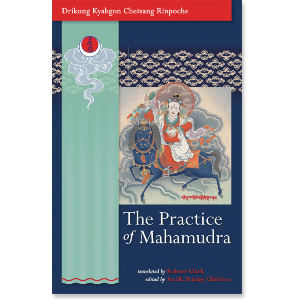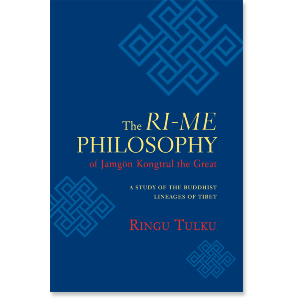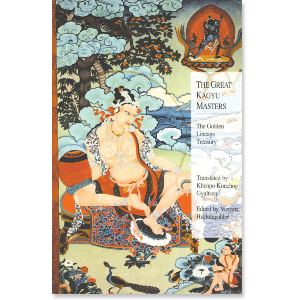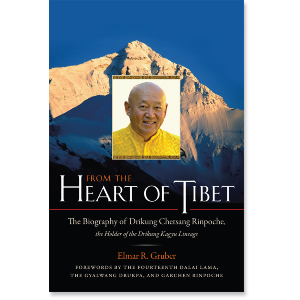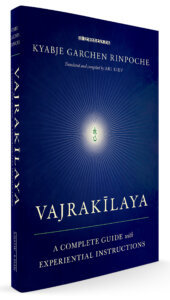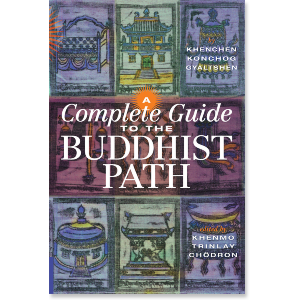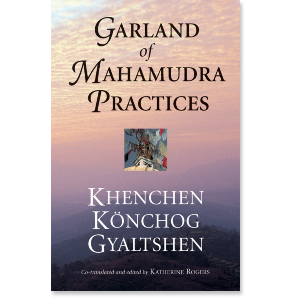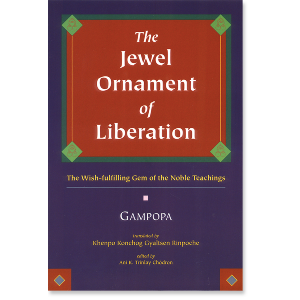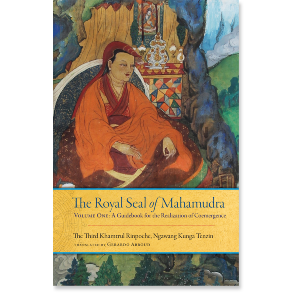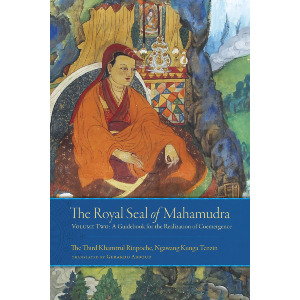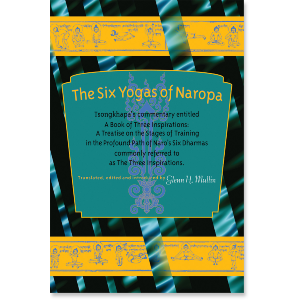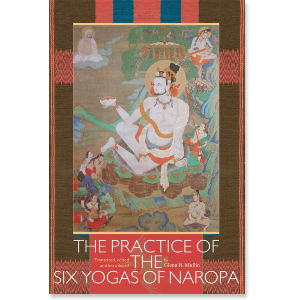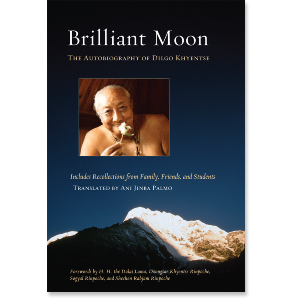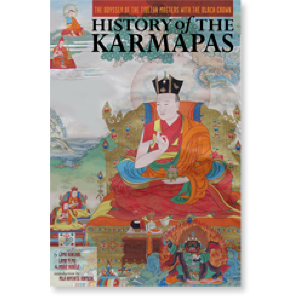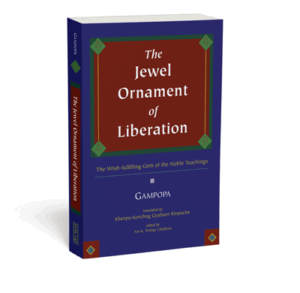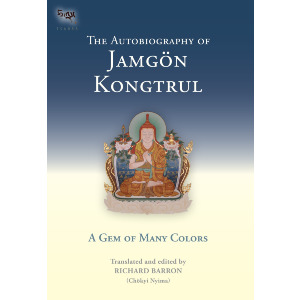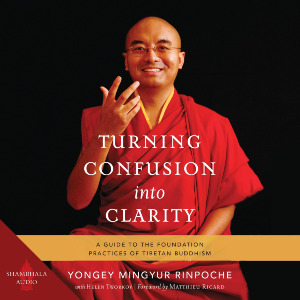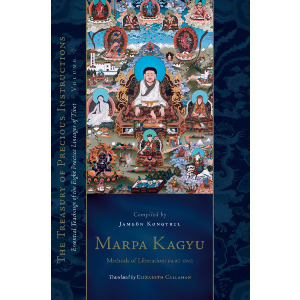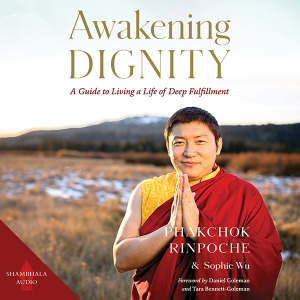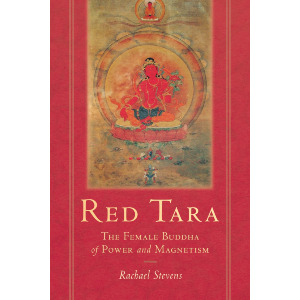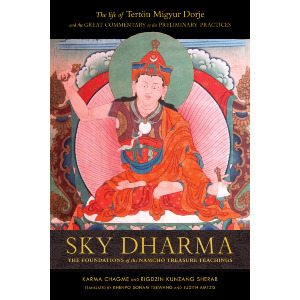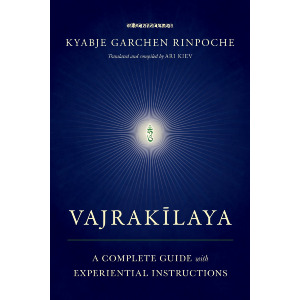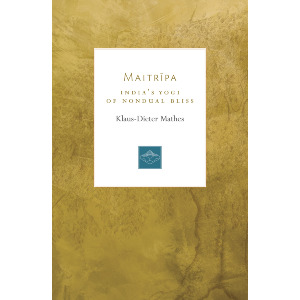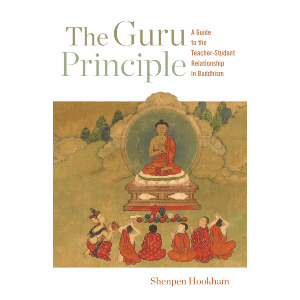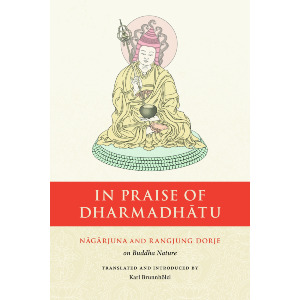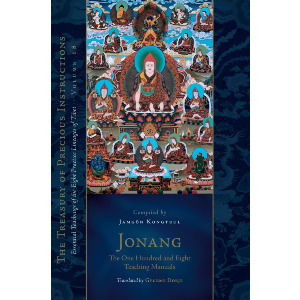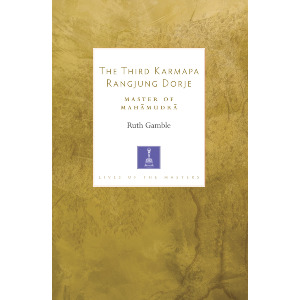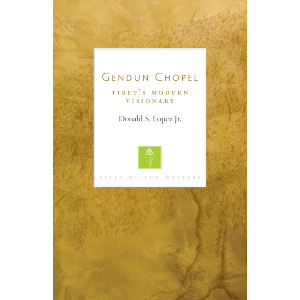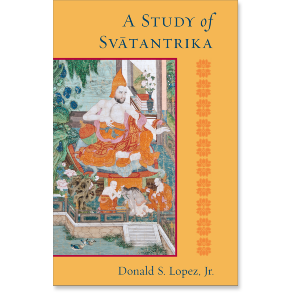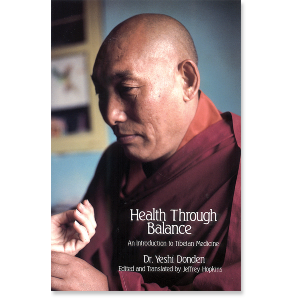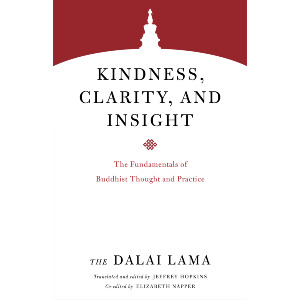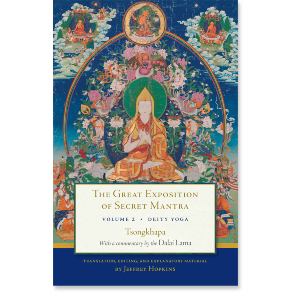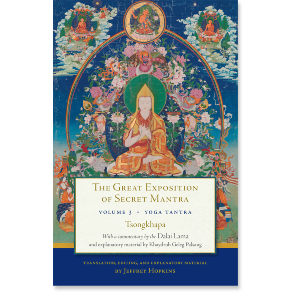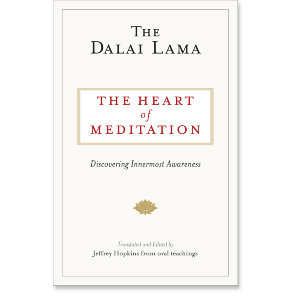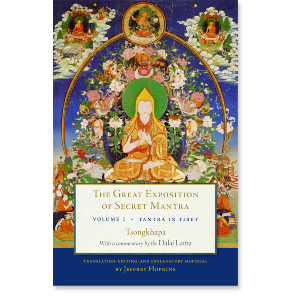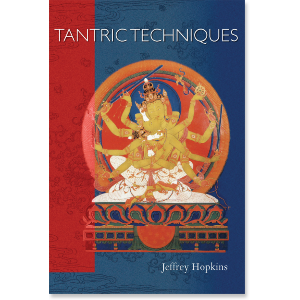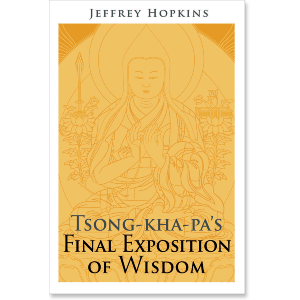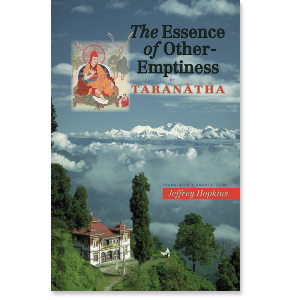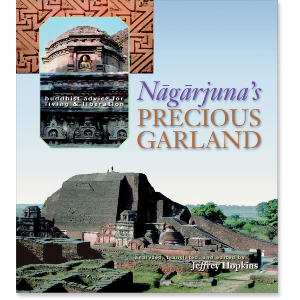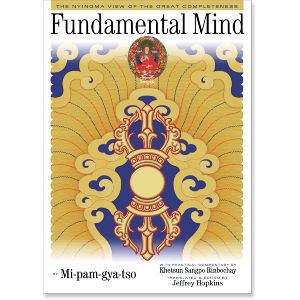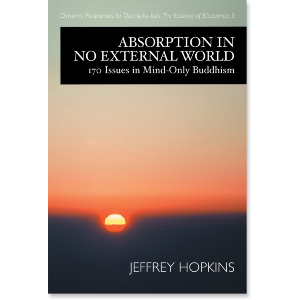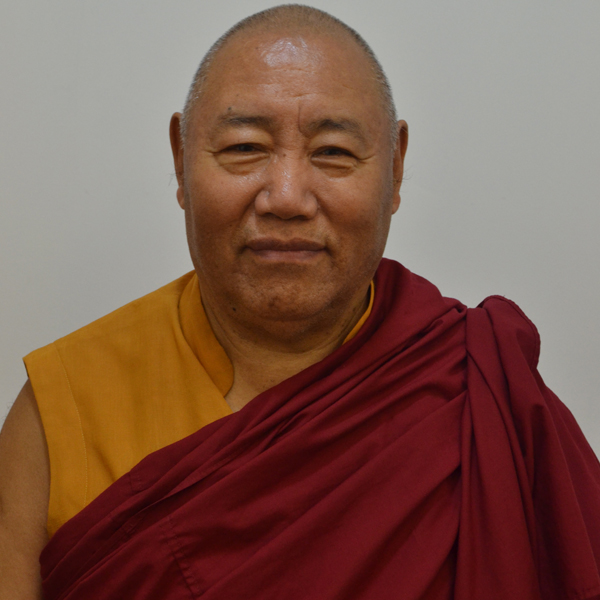

Khenchen Konchog Gyaltshen Rinpoche
Khenchen Könchog Gyaltshen, founder of several Buddhist centers worldwide, is respected and beloved as an accomplished scholar, meditation master, teacher, translator, and author. In 2001 he received the high honor of being enthroned as Khenchen (great abbot). He lives in Frederick, Maryland.
Khenchen Konchog Gyaltshen Rinpoche
-
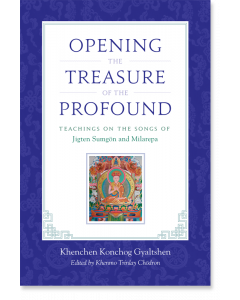 Opening the Treasure of the Profound$26.95- Paperback
Opening the Treasure of the Profound$26.95- Paperback -
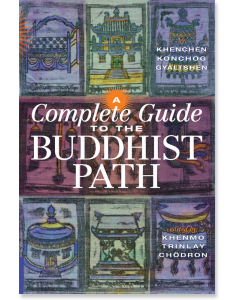 A Complete Guide to the Buddhist Path$32.95- Paperback
A Complete Guide to the Buddhist Path$32.95- Paperback -
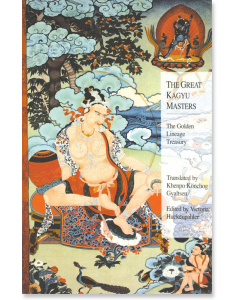 The Great Kagyu Masters$22.95- Paperback
The Great Kagyu Masters$22.95- PaperbackEdited by Victoria Huckenpahler
Translated by Khenchen Konchog Gyaltshen Rinpoche
By Dorje Dze Od -
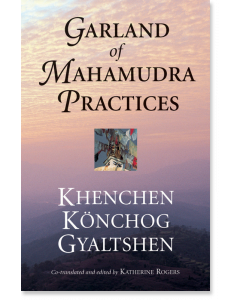 Garland of Mahamudra Practices$19.95- Paperback
Garland of Mahamudra Practices$19.95- PaperbackBy Khenchen Konchog Gyaltshen Rinpoche
Edited by Katherine Manchester Rogers
Translated by Katherine Manchester Rogers
By Gyalwang Kunga Rinchen -
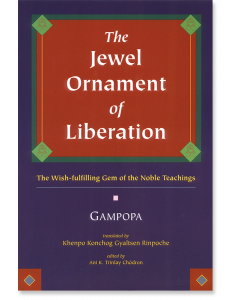 The Jewel Ornament of Liberation$39.95- Paperback
The Jewel Ornament of Liberation$39.95- PaperbackBy Gampopa
Edited by Ani K. Trinlay Chodron
Foreword by H.H. the Fourteenth Dalai Lama
Translated by Khenchen Konchog Gyaltshen Rinpoche
- Drukpa Kagyu Tradition 1 item
- Buddhist Biography/Memoir 1 item
- Buddhist Overviews 2item
- Introductions to Buddhism 1 item
- Drikung Kagyu 4item
- Drukpa Kagyu 1 item
- Kagyu Tradition 5item
- Karma Kagyu 1 item
- Shangpa Kagyu 1 item
- Lam Rim 1 item
- Mahamudra 1 item
- Ngondro 1 item
- Phowa 1 item
- TenRim 1 item
- Buddhist Poetry 1 item
- Biography 1 item
GUIDES

The following is the beginning of a several page profile of Marpa from Indestructible Truth: The Living Spirituality of Tibetan Buddhism:
Marpa, the Tibetan founder of the Kagyu¨ lineage, represents yet another type of person. Born in 1012 of relatively prosperous parents in southern Tibet, as a young boy Marpa is depicted as possessing a fearsome temper and a violent and stubborn disposition. He is what one might call a holy terror, and while he is still young his parents send him off to be trained in the dharma with a variety of teachers. Marpa soon realizes that one has to make a lot of offerings in order to receive even basic teachings, let alone more advanced ones. Moreover, Tibetan teachers often guard their transmissions jealously, and Marpa is repeatedly rebuffed when he seeks the higher initiations.
Eventually, he comes to the conclusion that to receive the full measure of dharma instruction, he will have to journey to India. His parents capitulate, and Marpa sets off over the Himalayas on a long, tedious, and dangerous journey to India, the first of three trips he will make to the holy land. While staying in Nepal before descending to the Indian plains, Marpa hears of the siddha Naropa. His biography states, ‘‘A connection from a former life was reawakened in Marpa and he felt immeasurable yearning.’’
While many of his Tibetan contemporaries arrived in India and went straight to one or another of the great Indian monasteries for tantric instruction, Marpa takes a different course, bypassing the monastic scene, seeking for his yogin teacher in the forest. Marpa eventually finds Naropa, is accepted as a disciple, and receives extensive instruction and initiation from him.
From the first Marpa Kagyu volume of the Treasury of Precious Instructions:
Marpa Chökyi Lodrö of Lhodrak traveled to India three or four times. He received the sūtras and tantras in their entirety from many scholar-siddhas, Nāropa and Maitrīpa being the foremost among them. In particular, if his earlier and later journeys are added together, he studied with Nāropa for sixteen years and seven months. Through the combination of his listening, reflection, and meditation, Marpa came to dwell in a state of attainment. During his last journey, Nāropa had departed for [the practice of yogic] conduct. Nevertheless, enduring great hardships, Marpa searched for and supplicated Nāropa, finally actually meeting him in Puṣpahari in the North. He spent seven months with Nāropa and received the complete Aural Transmission of Cakrasaṃvara, male and female consorts. In Tibet, the principal disciples upon whom Marpa bestowed his profound dharma were known as the four great pillars. Among them, Mai Tsönpo, Ngok Chödor, and Tsurtön received the entrusted transmission of the explanatory tradition, and Jetsun Milarepa received the entrusted transmission of the practice tradition.
Paperback | Ebook
$34.95 - Paperback
The Life of Marpa the Translator: Seeing Accomplishes All
By Tsangnyon Heruka, translated by Chogyam Trungpa amd the Nalanda Translation Committee
Marpa the Translator, the eleventh-century farmer, scholar, and teacher, is one of the most renowned saints in Tibetan Buddhist history. In the West, Marpa is best known through his teacher, the Indian yogin Naropa, and through his closest disciple, Milarepa. This lucid and moving translation of a text composed by the author of The Life of Milarepa and The Hundred Thousand Songs of Milarepa documents the fascinating life of Marpa, who, unlike many other Tibetan masters, was a layman, a skillful businessman who raised a family while training his disciples.
As a youth, Marpa was inspired to travel to India to study the Buddhist teachings, for at that time in Tibet, Buddhism has waned considerably through ruthless suppression by an evil king. The author paints a vivid picture of Marpa's three journeys to India: precarious mountain passes, desolate plains teeming with bandits, greedy customs-tax collectors. Marpa endured many hardships, but nothing to compare with the trials that ensued with his guru Naropa and other teachers. Yet Marpa succeeded in mastering the tantric teachings, translating and bringing them to Tibet, and establishing the Practice Lineage of the Kagyus, which continues to this day.
Essential Texts by and about Marpa
Hardcover | Ebook
$49.95 - Hardcover
Marpa Kagyu, Part One - Methods of Liberation: Essential Teachings of the Eight Practice Lineages of Tibet, Volume 7
The Treasury of Precious Instructions
By Jamgon Kongtrul Lodro Thaye
The seventh volume of the series, Marpa Kagyu, is the first of four volumes that present a selection of core instructions from the Marpa Kagyu lineage of Tibetan Buddhism. This lineage is named for the eleventh-century Tibetan Marpa Chokyi Lodrö of Lhodrak who traveled to India to study the sutras and tantras with many scholar-siddhas, the foremost being Naropa and Maitripa. The first part of this volume contains source texts on mahamudra and the six dharmas by such famous masters as Saraha and Tilopa. The second part begins with a collection of sadhanas and abhisekas related to the Root Cakrasamvara Aural Transmissions, which are the means for maturing, or empowering, students. It is followed by the liberating instructions, first from the Rechung Aural Transmission. This section on instructions continues in the following three Marpa Kagyu volumes. Also included are lineage charts and detailed notes by translator Elizabeth M. Callahan.
The pieces by Marpa in this volume include:
- Vajra Song on the Meaning of the Four Points: Instructions on the Ultimate Essence, the Mahāmudrā of Nonattention Heard by the Lord Marpa Lotsāwa from the Glorious Saraha
- Trulkhors for the Path of Method and the Caṇḍālī of the Saṃvara Aural Transmission
- Eighteen Trulkhors for Caṇḍālī
Paperback | Ebook
$39.95 - Paperback
The Rain of Wisdom: The Essence of the Ocean of True Meaning
Translated by Nalanda Translation Committee under the guidance of Chogyam Trungpa Rinpoche.
The art of composing spontaneous songs that express spiritual understanding has existed in Tibet for centuries. Over a hundred of these profound songs are found in this collection of the works of the great teachers of the Kagyü lineage, known as the Practice Lineage of Tibetan Buddhism.
The chapter on Marpa, entitled The Grand Songs of Marpa, is 35 pages long and includes Marpa's first departure from India, his dream of Saraha, his third trip to India, his final farewell to Naropa, his third return to Tibet, and the many songs these incidents inspired.
Paperback | Ebook
$27.95 - Paperback
The Great Kagyu Masters: The Golden Lineage Treasury
Compiled by Dorje Dze Öd, translated by Khenchen Konchog Gyaltshen Rinpoche
The Golden Lineage Treasury was compiled by Dorje Dze Öd a great master of the Drikung lineage active in the Mount Kailasjh region of Western Tibet. This text of the Kagyu tradition profiles and the forefathers of the tradition including Vajradhara, the Buddha, Tilopa, Naropa, the Four Great Dharma Kings of Tibet, Marpa, Milarepa, Atisha, Gampopa, Phagmodrupa, Jigten Sumgon, and more.
The profile Marpa is 25 pages long.
Hardcover | Ebook
$24.95 - Hardcover
The Supreme Siddhi of Mahamudra: Teachings, Poems, and Songs of the Drukpa Kagyu Lineage
Translated by Gerardo Abboud, Sean Price, and Adam Kane
The Drukpa Kagyu lineage is renowned among the traditions of Vajrayana Buddhism for producing some of the greatest yogis from across the Himalayas. After spending many years in mountain retreats, these meditation masters displayed miraculous signs of spiritual accomplishment that have inspired generations of Buddhist practitioners. The teachings found here are sources of inspiration for any student wishing to genuinely connect with this tradition.
These translations include Mahamudra advice and songs of realization from major Tibetan Buddhist figures such as Gampopa, Tsangpa Gyare, Drukpa Kunleg, and Pema Karpo, as well as modern Drukpa masters such as Togden Shakya Shri and Adeu Rinpoche. This collection of direct pith instructions and meditation advice also includes an overview of the tradition by Tsoknyi Rinpoche.
This includes a chapter on Marpa's A Vision of Saraha The Essential Importance of the Uncreated Meaning of the Four Syllables of Mahamudra: A Pith Instruction Expressed in a Vajra Song. The pith instruction, the essence of the uncreated found in the meaning of the four syllables of Mahamudra, was revealed to Lord Marpa by the song of Saraha.
Combined with guidance from a qualified teacher, these teachings offer techniques for resting in the naturally pure and luminous state of our minds. As these masters make clear, through stabilizing the meditative experiences of bliss, clarity, and nonthought, we will be liberated from suffering in this very life and will therefore be able to benefit countless beings.
Translator on Gerardo Abboud on The Supreme Siddhi of Mahamudra
Additional Resources on Marpa
Lotsawa House hosts at least eight works by Marpa as well as several where he features. 

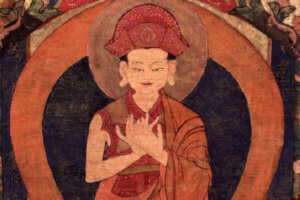
The Life of Jigten Sumgön, an excerpt
by Drigung Kyabgön Padmai Gyältsen
[An excerpt from Opening the Treasure of the Profound: Teachings on the Songs of Jigten Sumgon and Milarepa]
OM SVASTI
The victorious Shakya saw the five sights.
He showed the victorious path,
and, to expand the teachings, took birth again as the victorious
regent Ratna Shri.
I prostrate to him.
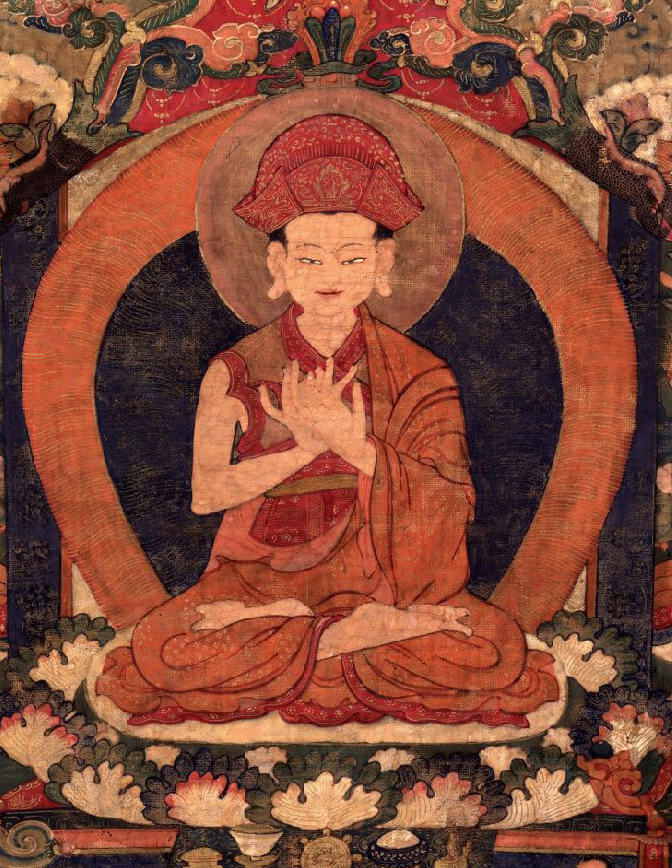
By treasuryoflives.org [Public domain], via Wikimedia Commons
Limitless kalpas ago, Jigten Sumgön was born as the Chakravartin Tsibkyi Mukhyu (Wheel Rim), who was the father of a thousand princes. But then he renounced the kingdom, attained enlightenment, and was called the Tathagata Nagakulapradipa (Tib. Lurik Drönma). Although he had already attained enlightenment, he appeared later as the bodhisattva Kunsang Wangkur Gyälpo. At the time of Buddha Kashyapa, he appeared as the potter Gakyong. At the time of Buddha Shakyamuni, he appeared as the Stainless Licchavi, who was inseparable from the Buddha himself. Later, he was born as Acharya Nagarjuna. Through all these births, he benefited the Buddha’s teachings and countless sentient beings.
Then, so that the essence of the Buddha’s teachings might flourish, Jigten Sumgön was born into a noble family in Tibet in 1143. His father was Naljorpa Dorje, a great practitioner of Yamantaka, and his mother was Rakshisa Tsünma. Many marvelous signs accompanied the birth. Jigten Sumgön learned the teachings of Yamantaka from his father, and by the age of four became expert in reading and writing. From his uncle, the Abbot Darma, the great Radreng Gomchen, the Reverend Khorwa Lungkhyer, and others, he learned many sutras and tantras. At that time, he was called Tsunpa Kyab and later, Dorje Päl.
Jigten Sumgön’s coming was predicted in many sutras, tantras, and termas. For example, in the Yeshe Yongsu Gyepai Do (Completely Expanded Wisdom Sutra) it is said: “In the northern snow ranges will appear a being called Ratna Shri. He will benefit my teachings and be renowned in the three worlds.” In the Gongdü (Quintessential Sublime Vision) it is said: “At a place called Dri, the Source of the Dharma, Ratna Shri will appear in the year of the Pig. He will gather a hundred thousand fully ordained monks. After that he will go to the Abhirati (Tib. Ngönga) buddhafield. He will be called Stainless White Sugata and have a large retinue.” In the Gyälpo Kaithang it is said: “Northeast of glorious Samye, at a place called Drigung, the source of the Dharma, the Lord-King Trisong Detsän will be born in the year of the Pig as the sugata Ratna Shri. He will gather a hundred thousand bodhisattvas. He will go to the Abhirati buddhafield and be called Stainless White Sugata. In that buddhafield, he will become the fully perfected king, the perfected Dharma teacher.” Thus, his coming was clearly predicted.
When Jigten Sumgön was still young, his father passed away. His family’s fortunes declined, so he had to support his family by reading scriptures. Once he was offered a goat. As he led it away, it tried to break loose; he pulled back, but the goat dragged him for a short distance and he left his footprints in the rock. When he was eight, he had a vision of Yamantaka. On another occasion, while meditating at Tsib Lungmoche, he saw all the phenomena of samsara and nirvana as insubstantial, like a reflection in a mirror. Even when he was in Kham he was renowned as a yogin.
Jigten Sumgön realized the practices of mahamudra and luminosity, and in his sleep he visited the Arakta Padma buddhafield. As mentioned earlier, from the great Radreng Gomchen he learned all the teachings of the Kadam tradition. From Lama Lhopa Dorje Nyingpo he received the teachings of Guhyasamaja and others. Once when there was a drought in Kham, he took the food offered to him as a fee for his reading and distributed it to those who were starving. Thus, he saved many lives.
Many important people began to approach Jigten Sumgön for teachings. One, Gönda Pandita, who came from Central Tibet, told him about Phagmo Drupa. Just by hearing the name of that being, Jigten Sumgön’s mind quivered like the leaves of a kengshu tree blown by the wind. Enduring great hardship, he traveled from Kham to Central Tibet. A rainbow stretched the length of his journey, and the protector Dorje Lekpa took the forms of a rabbit and a child and attended him, looking after his needs. When he came to the dangerous, rocky path of Kyere, a natural formation of the six-syllable mantra transformed itself into a vision of the face of Phagmo Drupa.
Jigten Sumgön traveled day and night. On the way, he met a woman and man who said, “We have come from Phagmo Dru.” Seeing them as the guru’s emanations, he prostrated to them. He arrived at the Phagdru Monastery at midnight, and a Khampa invited him inside. When he met Phagmo Drupa, the guru said, “Now, all of my disciples are present.” Jigten Sumgön then offered his teacher a bolt of silk, a bolt of plain cloth, and his horse. Phagmo Drupa refused the horse, explaining that he did not accept offerings of animals. Jigten Sumgön also offered a bag of food, which Phagmo Drupa used to perform a feast offering to Chakrasamvara. Then Phagmo Drupa gave Jigten Sumgön the twofold bodhisattva vow and the name Bodhisattva Ratna Shri. As one vessel fills another, Phagmo Drupa gave Jigten Sumgön all the teachings of sutra and tantra.
At that time, there lived a woman who was an emanation of Vajrayogini. Phagmo Drupa suggested to Taklung Thangpa that he stay with her; but Taklung Thangpa, not wishing to give up his monk’s vows, refused, and shortly afterward the emanation passed away. Lingje Repa then fashioned a cup from the woman’s skull. This made him late for an assembly, and the food offerings had already been distributed by the time he arrived. Taking the skull cup, he circulated among the monks, receiving offerings of food from each. The monks gave only small portions, but Phagmo Drupa gave a large amount, filling the skull cup completely. Jigten Sumgön gave even more, forming a mound of food which covered the skull cup like an umbrella. Lingje Repa then walked again through the assembly, and as he walked he spontaneously composed and sang a song of praise in twenty verses. Finally, he stopped in front of Jigten Sumgön, offering the food and the song to him.
One day, Phagmo Drupa wanted to see if any special signs would arise concerning his three closest disciples, so he gave each of them a foot of red cloth with which to make a meditation hat. Taklung Thangpa used only what he had. Lingje Repa added a piece of cotton cloth to the front of his hat, and Jigten Sumgön added a second foot of cloth to his, making it much larger. This was considered very auspicious. On another occasion, Phagmo Drupa called Jigten Sumgön and Taklung Thangpa and said, “I think that the Tsangpo River is overflowing today. Please go and see.” Both disciples saw the river following its normal course, and returned; but Jigten Sumgön, thinking there was some purpose in the guru’s question, told him, “The river has overflowed, and Central Tibet and Kham are now both under water.” This foretold the flourishing of Jigten Sumgön’s activities, and he became known as a master of interdependent origination.
At this time, in accordance with the prediction made by Phagmo Drupa, Jigten Sumgön still held only the vows of an upasaka. One day, Phagmo Drupa asked him to remain behind after the assembly and instructed him to sit in the seven-point posture of Vairochana. Touching him on his head, throat, and heart centers, he said om, ah, hung three times and told him, “You will be a great meditator, and I will rejoice.”
Jigten Sumgön attended Phagmo Drupa for two years and six months. During that time, he received all of his guru’s teachings and was told that he would be his successor. At the time of Phagmo Drupa’s parinirvana, a radiant five-pronged golden vajra emanated from his heart center and dissolved into the heart center of Jigten Sumgön; this was seen by the other disciples. Jigten Sumgön then gave all his belongings to benefit the monastery and to help build the memorial stupa for his guru.
After this, he met many other teachers. From Dakpo Gomtsul he received the four yogas of mahamudra. A patroness then promised him provisions for three years, and Jigten Sumgön, earnestly wishing to practice the teachings he had received, retired to Echung Cave to meditate. In those three years, he gained a rough understanding of the outer, inner, and secret aspects of interdependent origination. He then realized that the cause of wandering in samsara is the difficulty wind has in entering the channels, and so he practiced moving the wind, saw many buddhas and bodhisattvas face to face, and had visions of his mind purifying the six realms. Then he went on a pilgrimage to Phagdru and other holy places.
On his return to Echung Cave, he practiced with one-pointed mind. In the same way that Mara arose as obstacles to Lord Buddha at the time of his enlightenment, and the Five Sisters and others tried to hinder Milarepa, the final fruition of Jigten Sumgön’s karma then arose, and he contracted leprosy. Becoming intensely depressed, he thought, “Now I should die in this solitary place and transfer my consciousness.” He prostrated to an image of Avalokiteshvara that had been blessed many times by Phagmo Drupa. At the first prostration, he thought, “Among sentient beings, I am the worst.” At the second, he thought, “I have all the teachings of my guru, including the instructions of bardo and the transference of consciousness, and need have no fear of death.” Then, remembering that other beings didn’t have these teachings, he sat down and generated profoundly compassionate thoughts toward others. His sickness left him, like clouds blown away from the sun, and at that moment he attained buddhahood. He had practiced at the Echung cave for seven years.
Shortly after this, he had a vision of the seven Taras. Because he had a full understanding of interdependent origination, and had realized the unity of discipline and mahamudra, he took the vows of a fully ordained monk. From this time on, Jigten Sumgön did not eat meat. As he had already been named Phagmo Drupa’s successor, the chief monks of his guru’s monastery invited him to return.
After taking the abbot’s seat at the monastery, Jigten Sumgön insisted on a strict observance of monastic discipline. One day, some monks said, “We are the ‘nephews’ of Milarepa and should be allowed to drink chang.” Saying this, they drank. When Jigten Sumgön admonished them, they replied, “You yourself should keep the discipline of not harming others.” Phagmo Drupa then appeared in a vision to Jigten Sumgön and said to him, “Leave this old, silken seat and go to the north. There you will benefit many sentient beings.”
Jigten Sumgön went north and, on the way, at Nyenchen Thanglha, he was greeted by the protector of that place. At Namra, a spirit king and his retinue took the upasaka vow from him, and Jigten Sumgön left one of his footprints behind as an object of devotion for them. He gave meditation instructions to vultures flying overhead, and they practiced according to those teachings. Once, at a word from Jigten Sumgön, a horse that was running away returned to him. He also sent an emanation of himself to Bodh Gaya to pacify a war begun by Duruka tribesmen.
On another occasion, at Dam, he gave teachings to a large gathering and received many offerings. At the end of a day which had seemed very long, he told the crowd, “Now go immediately to your homes,” and suddenly it was just before dawn of the next day. To finish his talk, Jigten Sumgön had stopped the sun. When he was at Namra Mountain, Brahma, the king of the gods, requested the vast and profound teachings. On the way to Drigung, the great god Barlha received him. The children of Dzänthang built a throne for Jigten Sumgön, and he sat there and instructed the people of that town. Even the water, which has no mind, listened to his teachings and made the sound “Nagarjuna.”
Then he came to Drigung Thil. In his thirty-seventh year, he established Drigung Jangchub Ling and appointed Pön Gompa Dorje Senge as supervisor for the construction of the monastery. Many monks gathered there and enjoyed the rainfall of profound Dharma.
In Tibet, there are nine great protectors of the Dharma. Among them, Barlha, Sogra, Chuphen Luwang, Terdrom Menmo, and Namgyäl Karpo bowed down at Jigten Sumgön’s feet, took the upasaka vow, and promised to protect the teachings and practitioners of the Drigung lineage.
At one time, water was very scarce in Drigung. Jigten Sumgön gave 108 pieces of turquoise to his attendant, Rinchen Drak, with instructions to hide them in various places. Rinchen Drak hid all but one, which he kept for himself and put in his robe. The pieces he hid became sources of water, and the one he kept turned into a frog. Startled, he threw it away, and in falling it became blind in one eye. Where the frog landed, a stream called “Blind Spring” arose. Most of the streams were dried up by fire when Drigung Thil was destroyed around the end of the thirteenth century, but some still remain.
Twice a month, on the new and full moons, Jigten Sumgön and his monks observed a purification ceremony called sojong. Once some monks arrived late, and Jigten Sumgön decided to discontinue the practice, but Brahma requested him to maintain that tradition, and he agreed.
Jigten Sumgön continued to look after his old monastery at Phagdru, Dänsa Thil. Once when he was at Daklha Gampo, Gampopa’s seat, dakinis brought an assembly of 2,800 yidams on a net of horsehair and presented them to him. To memorialize Phagmo Drupa, he built an auspicious stupa of many doors, and placed images of those yidams inside compartments, with a door for each of them. The tradition of building stupas of this type originated from this. While he was visiting Daklha Gampo, light rays streamed forth from Gampopa’s image, merging inseparably with Jigten Sumgön, and he attained both the ordinary and extraordinary siddhis of the treasure of space. In a vision, he met with Ananda and discussed the teachings.
Once Lama Shang said, “This year, the dakinis of Oddiyana will come to invite me and the Great Drigungpa to join them. He is a master of interdependent origination and won’t have to go there, but I should go.” Soon after this, the dakinis came for him and he passed away; but when they came to invite Jigten Sumgön, he refused to go, and the dakinis changed their prayer of invitation to a supplication for the guru’s longevity. Then all the dakas and dakinis made offerings to him and promised to guide his disciples.
Jigten Sumgön had many important students. Among them, the leaders of the philosophers were the two Che-ngas, the great abbot Gurawa, Nyö Gyälwa Lhanangpa, Gar Chöding, Pälchen Chöye, Drupthob Nyakse, and the two Tsang-tsangs. The foremost vinaya holders were Thakma Düldzin and Dakpo Düldzin. The Kadampa geshe was Kyo Dorje Nyingpo. Among the translators were Nup, Phakpa, and others. The leaders of the tantrikas were Tre and Ngok. The leaders of the yogins were Düdsi, Bälpu, and others. When Jigten Sumgön taught, rainbows appeared and gods rained flowers from the sky. Machen Pomra and other protectors listened to his teachings, and the kings of Tibet, India, and China were greatly devoted to him. At this time, Jigten Sumgön had 55,525 followers. To feed this ocean of disciples, Matrö, the king of the nagas and the source of all the wealth of Jambudvipa, acted as patron for the monastery.
Near Drigung Thil there was a rock called Lion Shoulder, which Jigten Sumgön saw as the mandala of Chakrasamvara. He established a monastery there and, to spread the teachings and benefit sentient beings, built another auspicious stupa of many doors using a special method. He also repaired Samye Monastery.
Jigten Sumgön’s main yidam practice was the Chakrasamvara of Five Deities, and he sometimes manifested in that form in order to work with those who were difficult to train. When a war began in Minyak in Eastern Tibet, he protected the people there through his miracle power. The number of his disciples increased to 70,000. Many of the brightest of these attained enlightenment in one lifetime, while those of lesser intelligence attained various bhumis, and everyone else realized at least the nature of his or her own mind.
In one of the predictions about Jigten Sumgön it was said, “A hundred thousand incarnate great beings, tulku, will gather.” Here, “tulku” meant that they would be monks and have perfect discipline, and “great beings” meant that they would all be bodhisattvas. In other life stories, it is said that in an instant Jigten Sumgön visited all the buddhafields, saw buddhas such as Amitabha and Akshobhya, and listened to their teachings. Jigten Sumgön himself said that whoever so much as heard his name and had the chance to go to Layel in Drigung would be freed from birth in the lower realms, and that whoever supplicated him—whether from near or far away—would be blessed, and his or her meditation would grow more firm. He also said that all sentient beings living in the mountains of Drigung, even the ants, would not be born again in lower realms.
From the essence of the instructions of sutra and tantra, Jigten Sumgön gave teachings which were compiled by his disciple Che-nga Sherab Jungne into a text called Gong Chig, which has 150 vajra statements and 40 additional verses in an appendix.
A naga king named Meltro Zichen once went to Drigung for teachings. Jigten Sumgön sent a message to his disciples to remain in seclusion so that those with miracle power would not harm the naga, and those without such power would not be harmed themselves. The message was given to everyone but the Mahasiddha Gar Dampa, who was in meditation in the depths of a long cave. When the naga arrived, he made a loud noise which was heard even by Gar Dampa. He came out to see what was happening and saw a frightening, dark blue snake whose length circled the monastery three times and whose head looked in at the window of Jigten Sumgön’s palace. Without examining the situation, he thought that the naga was there to harm his guru, so he manifested as a giant garuda which chased the naga away. At Rölpa Trang, there is a smooth and clear print left by the naga, and at Dermo Mik there is a very clear claw mark left by the garuda when it landed on a rock. Near the river of Khyung-ngar Gel there are marks left by both the garuda and the naga.
A Sri Lankan arhat, a follower of the Buddha, once heard that Mahapandita Shakya Shri Bhadra was going to Tibet, and he gave that teacher’s brother a white lotus, asking that he give it to the Mahapandita to give to Nagarjuna in Tibet. When Shakya Shri Bhadra arrived in Tibet, he ordained many monks, but didn’t know where to find Nagarjuna. When giving ordination, he would usually distribute robes, but once, when an ordinary disciple of Jigten Sumgön approached him for ordination and asked for a robe, none were left. Nonetheless, he insisted strongly. One of Shakya Shri Bhadra’s attendants pushed him away and he fell, causing blood to come from his nose.
Before this, Shakya Shri Bhadra had been accustomed to seeing Tara in the morning when he recited the seven-branch prayer, but for six days after this incident she didn’t show herself. Then, on the seventh day, she appeared with her back turned to him. “What have I done wrong?” he asked her. “Your attendant beat a disciple of Nagarjuna,” she replied, “and brought blood from his nose.” When he asked how he could purify this misdeed, Tara told him, “Make as many Dharma robes as you have years, and offer them to fully ordained monks who have no robes.” Shakya Shri Bhadra then searched for the monk who had been turned away. When he found him, and learned the name of his teacher, he realized that Jigten Sumgön was Nagarjuna’s incarnation. So he sent one of his attendants to offer the white lotus to Jigten Sumgön. In return, Jigten Sumgön sent many offerings of his own and asked that Shakya Shri Bhadra visit Drigung, but the Mahapandita could not go there, though he sent many verses of praise. Because Nagarjuna had knowingly taken birth as Jigten Sumgön in order to dispel wrong views and was teaching at Drigung, Shakya Shri Bhadra saw that there was no need for him to go there.
At this time, many lesser panditas were visiting Tibet. One of them, Vibhuti Chandra, said, “Let us talk with the Kadampas; the followers of mahamudra tell lies.” Shakya Shri Bhadra replied, “Because Jigten Sumgön is a great teacher, you should now apologize for having said these things.” Vibhuti Chandra then went to Drigung, made a full apology, and constructed an image of Chakrasamvara at Sinpori Mountain. He also translated into Sanskrit one of Jigten Sumgön’s writings about the fivefold path of mahamudra, named Tsin-dha Mani.
One day, a great scholar named Dru Kyamo came to Drigung from Sakya to debate with Jigten Sumgön. When he saw the guru’s face he saw him as the Buddha himself, and his two chief disciples—Che-nga Sherab Jungne and Che-nga Drakpa Jungne—as Shariputra and Maudgalyayana. There was no way he could debate with Jigten Sumgön after this. His devotion blossomed fully, and he became one of Jigten Sumgön’s principal disciples. Later, he was called Ngorje Repa and wrote a text called Thegchen Tenpai Nyingpo as a commentary on Jigten Sumgön’s teachings.
The number of Jigten Sumgön’s disciples continued to increase. At one rainy season retreat, 100,000 morality sticks were distributed to count the monks attending. Not long after that, 2,700 monks were sent to Lapchi, and equal numbers were sent to Tsari and Mount Kailash, but by the next year 130,000 monks had again gathered at Drigung.
Karmapa Düsum Khyenpa once came to Drigung after visiting Daklha Gampo. At Bam Thang, Jigten Sumgön and his disciples received him warmly. At that time, the Karmapa saw Jigten Sumgön as the Buddha and his two chief disciples as Shariputra and Maudgalyayana, surrounded by arhats. When they returned to the main assembly hall, the Serkhang, the Karmapa again saw Jigten Sumgön as the Buddha, with his two disciples appearing as Maitreya and Manjushri, surrounded by bodhisattvas. Thus, Düsum Khyenpa showed great devotion and received many teachings. He also saw the entire area of Drigung as the mandala of Chakrasamvara.
The question arose of who would hold the lineage after Jigten Sumgön’s passing. Jigten Sumgön had confidence in many of his disciples, but had thought for a long time that the succession should pass to one of his family clan, the Drugyäl Kyura. Since he had been born in Kham, he sent one of his disciples, Pälchen Shri Phukpa, there to teach his family members. Displaying miracle power and proclaiming his guru’s reputation, Pälchen Shri Phukpa taught Jigten Sumgön’s uncle Könchog Rinchen and his uncle’s son Anye Atrak and grandsons. Their minds became attracted to the teachings, and they moved to Central Tibet. Their stories are told in the Golden Rosary of the Drigung Kagyu.
One day Jigten Sumgön told his disciple Gar Chöding to go to the Soksam Bridge and offer a torma to the nagas living in the water. “You will receive special wealth,” he told him. A naga king named Sokma Me offered Gar Chöding a tooth of the Buddha and three special gems. Generally, it is said that this tooth had been taken by the naga king Dradrok as an object of devotion. This was the same naga who usually lived in the area of Magadha but had access to Soksam by way of an underwater gate. Gar Chöding offered the tooth and gems to Jigten Sumgön, who said, “It is good to return wealth to its owner,” indicating that the tooth had once been his own. “As you are wealthy,” he continued, “you should make an image of me and put the tooth in its heart.” A skilled Chinese artisan was then invited to build the statue, and the tooth was enshrined there as a relic. Jigten Sumgön consecrated this statue hundreds of times. It was kept in the Serkhang and called Serkhang Chöje (Dharma Lord of Serkhang). Its power of blessing was regarded as being equal to that of Jigten Sumgön himself. It spoke to many shrine keepers, and to a lama named Dawa it taught the Six Dharmas of Naropa. Later, when Drigung was destroyed by fire, it was buried in the sand for protection. When the Drigung Kyabgön returned to rebuild the monastery, a search was made for the statue, which came out of the sand by itself, saying, “Here I am!” Thus, this image possessed great power. Gar Chöding made many other images of Jigten Sumgön at this time.
Jigten Sumgön had by then grown old and could not often travel to Dänsa Thil. He sent Che-nga Drakpa Jungne there as his Vajra Regent, and that disciple’s activities were very successful. Under the leadership of Panchen Guhya Gangpa, Jigten Sumgön sent 55,525 disciples to stay at Mount Kailash. Under Geshe Yakru Päldrak, 55,525 were sent to Lapchi. Under Dordzin Gowoche, 55,525 were sent to Tsari. Even at the time of Chungpo Dorje Drakpa, the fourth successor to Jigten Sumgön, there were 180,000 disciples at Drigung.
Once, Jigten Sumgön went to the Dorje Lhokar Cave at Tsa-uk. “This cave is too small,” he said, and stretched, causing the cave to expand and leaving the imprint of his clothes on the rock. Because the cave was dark, he pushed a stick through the rock, making a window. He then made shelves in the rock to hold his belongings. All of these can be seen very clearly. Jigten Sumgön also left many footprints in the four directions around the area of Drigung.
One day, Jigten Sumgön fell ill. Phagmo Drupa appeared to him in a vision and explained a yogic technique by means of which he became well again. Jigten Sumgön taught according to the needs of his disciples. To some, according to their disposition, he gave instructions in the practice of the Eight Herukas of the Nyingma tradition.
Toward the end of his life, he predicted a period of decline for the Drigung lineage. Taking a small stick that he used to clean his teeth, he planted it in the ground and said, “When this stick has reached a certain height,
I will return.” This foretold the coming of Gyälwa Kunga Rinchen. Jigten Sumgön asked Che-nga Sherab Jungne to be his successor, but the latter declined out of modesty. Then he asked the great abbot Gurawa Tsültrim Dorje, who agreed.
In order to encourage the lazy to apply themselves to the Dharma, Jigten Sumgön entered parinirvana at the age of seventy-five, in the year of the Fire Ox (1217). His body was cremated on the thirteenth day of the month of Vaishaka. Gods created clouds of offerings, and flowers rained down from the sky to the level of one’s knees. His skull was untouched by the fire, and his brain appeared as the mandala of the sixty-two deities of Chakrasamvara more clearly than if a skilled artist had painted it. His heart also was not touched by the fire and was found to have turned a golden color. Likewise, countless relics appeared.
After Jigten Sumgön’s passing, most of the funerary responsibilities were taken on by Che-nga Sherab Jungne, even though he had earlier declined the succession. He went to Lion Shoulder (Tib. Senge Phungpa) Mountain to view the mandala of Chakrasamvara, saw Jigten Sumgön there, and thought that he should build a memorial in that place. Jigten Sumgön then again appeared in a vision on the mountain of the Samadhi Cave and said to him, “Son, do as you wish, but also follow my intention.” Then he disappeared. Doing as he wished, Che-nga Sherab Jungne built an auspicious stupa of many doors called “Sage, Overpowerer of the Three Worlds.” In that stupa, he put Jigten Sumgön’s heart and many other relics. Following his guru’s intention, he built the stupa “Body-essence, Ornament of the World,” which was made of clay mixed with jewel dust, saffron, and various kinds of incense. In that stupa, he put Jigten Sumgön’s skull and brain, along with many other relics, including vinaya texts brought from India by Atisha, and the Hundred-Thousand-Stanza Prajñaparamita.
Jigten Sumgön now abides in the Eastern Great All-Pervading Buddhafield, surrounded by limitless numbers of disciples from this earth who died with strong devotion to him. When such people die, they are immediately born there. Jigten Sumgön places his hand on their heads, blessing them, and welcoming them there.
$27.95 - Paperback
By: Drikung Kyabgon Chetsang Rinpoche & Khenmo Trinlay Chodron & Robert Clark
$22.95 - Paperback
By: Khenchen Konchog Gyaltshen Rinpoche & Victoria Huckenpahler
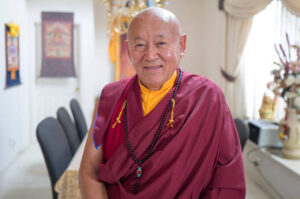
The Drikung Kagyu: A Reader's Guide
What follows is a guide to some of our books and other resources available on Shambhala.com that relate to the Drikung Kagyu tradition of Tibetan Buddhism. The Drikung lineage comes from Marpa, Milarepa, and Gampopa through Phagmo Drupa and Jigten Sumgön, who is considered the root of the tradition. His most famous work, the Gongchik, or “Single Intention,” is a collection of profound statements summarizing the entirety of the Buddhist path for which several famous commentaries have been written. Jigten Sumgön (1143–1217) is also known for his special teachings on Mahayana, Mahamudra, and the Six Yogas of Naropa. After Jigten Sumgön established a monastery and retreat center at Drikung Thil in central Tibet, the lineage flourished, becoming one of the most influential Tibetan Buddhist traditions. Over the centuries the Drikung Kagyu have established monasteries throughout Tibet and the greater Himalayan region, and have recently established meditation centers internationally, including in the United States, Germany, and Vietnam.
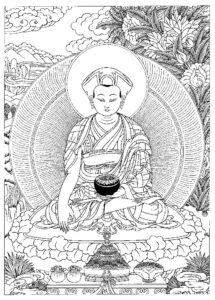
The Head of the Drikung Kagyu
The current heads of the lineage are His Holiness Drikung Kyabgon Chetsang Rinpoche and His Holiness Drikung Kyabgon Chungtsang Rinpoche. His Holiness Chungtsang Rinpoche still resides and teaches in Tibet in Lhasa, while His Holiness Chetsang Rinpoche lives in India and regularly travels throughout the world to impart Buddhist teachings.
The story of His Holiness Chetsang Rinpoche is at once amazing, heartbreaking, and inspiring. It is told in From the Heart of Tibet: The Biography of Drikung Chetsang Rinpoche, the Holder of the Drikung Kagyu Lineage. This biography traces His Holiness's journey from his recognition as a tulku and early training to an oppressed life under the Chinese to his escape to India and then to the United States and eventually back to India, where he founded the Drikung Kagyu Institute, the Songtsen Library, and Samtenling Nunnery. His Holiness Chetsang Rinpoche has also established retreat centers both in India and abroad. His Holiness is an avid historian, environmentalist, and a passionate advocate for world peace.
The Drikung Kagyu are well known for their unique presentation of the Five Paths of Mahamudra, a program that includes: arousing bodhichitta, deity visualization, guru yoga, Mahamudra meditation, and finally, dedication of merit. In The Practice of Mahamudra, His Holiness presents this fivefold teaching, which includes advice from Tilopa and Gampopa.

$27.95 - Paperback
By: Drikung Kyabgon Chetsang Rinpoche & Khenmo Trinlay Chodron & Robert Clark
New Releases
Kyabje Garchen Rinpoche is a Buddhist teacher of the Drikung Kagyu tradition. In Vajrakilaya he offers a complete manual for the visualization and supplication of the deity Vajrakīlaya. This ancient tantric practice centers on familiarizing oneself with the wrathful deity as a method for traversing the path to enlightenment. With clear instructions and insightful commentary, Garchen Rinpoche highlights the cultivation of bodhicitta at every stage of the path. This comprehensive guide to deity practice by one of the greatest living Tibetan meditation masters will support practitioners of all experiential levels in reuniting with their own awakened nature.
Works from Khenchen Konchog Gyaltsen
Khenchen Konchog Gyaltsen is another great contemporary scholar of the Drikung and has published multiple works with an emphasis on the Drikung Kagyu teachings.
Opening the Treasure of the Profound: Teachings on the Songs of Jigten Sumgön and Milarepa is a wonderful collection of vajra songs. It also includes over sixty pages on Jigten Sumgön by His Holiness Chetsang Rinpoche, Ngorje Repa (a student of Sakya Sribhadra and Jigten Sumgön) and Drikung Kyabgon Padmai Gyaltsen.
A Complete Guide to the Buddhist Path is Khenchen's presentation of The Jewel Treasury of Advice, a text composed by Drikung Bhande Dharmaradza (1704–1754), the reincarnation of Drikung Dharmakirti, Rigdzin Chokyi Drakpa (1595–1659). This work includes advice for meditators, Mahayana practitioners, and Vajrayana practitioners. The teachings include Mahamudra preparation and practice, dispelling obstacles, the Six Yogas of Naropa, and the final result of practice.
The Great Kagyu Masters: The Golden Lineage Treasury brings the lives and teachings of many of the great Kagyupas to light. From Vajradhara to Jigten Sumgön, this collection also includes Shakyamuni Buddha himself, Tilopa, Naropa, the Four Great Dharma Kings, Marpa, Milarepa, Atisha, Gampopa, Phagmo Drupa, and more.
The Garland of Mahamudra Practices is a translation of Clarifying the Jewel Rosary of the Profound Five-Fold Path by Kunga Rinchen, the Dharma heir to Jigten Sumgön. It begins with instructions on ngondro followed by a special set of preliminary practices focused on generating love, compassion, and bodhichitta. It then goes into the main practices of deity yoga, meditation on the guru as the four kayas, meditation on Mahamudra and the view, and the pith instructions on the nature of mind.
Garland of Mahamudra Practices
$19.95 - Paperback
By: Khenchen Konchog Gyaltshen Rinpoche & Katherine Manchester Rogers
$22.95 - Paperback
By: Khenchen Konchog Gyaltshen Rinpoche & Victoria Huckenpahler
Khenchen Konchog Gyaltsen has also translated Gampopa's Jewel Ornament of Liberation, which is a core text across all Dakpo Kagyu traditions.
The Jewel Ornament of Liberation
$39.95 - Paperback
By: Khenmo Trinlay Chodron & Gampopa & Khenchen Konchog Gyaltshen Rinpoche
Classic Kagyu Texts
Though specific to the Drukpa Kagyu tradition, The Third Khamtrul Rinpoche references Jigten Sumgön throughout his extraordinary text The Royal Seal of Mahamudra, Volume One: A Guidebook for the Realization of Coemergence. Both volume one and two are excellent resources for the meditative approach according to the Kagyu tradition.
Other Influences and Mentions of the Drikung Kagyu Tradition
There are also two works on the practice tradition of the Six Yogas of Naropa with an emphasis on the Gelug tradition. These works both highlight the centrality of the Drikung Kagyu lineage in the transmission of these practices to Tsongkhapa: The Six Yogas of Naropa: Tsongkhapa's Commentary and The Practice of the Six Yogas of Naropa.
In Dilgo Khyentse Rinpoche's autobiography Brilliant Moon, the Drikung Kagyu tradition comes up several times. The first is when he was young and staying in Draktsa, he had a vision of what he thought was Tseringma, which he attributed to the long presence of disciples of the Gyalwa Drikungpa (Jigten Sumgön) staying there in archaic times. Later, His Holiness Chetsang Rinpoche became his student and he taught him extensively, including spending two months imparting the Treasury of Precious Instructions.
$39.95 - Paperback
By: H.H. the Fourteenth Dalai Lama & Dilgo Khyentse Rinpoche & Ani Jinba Palmo & Shechen Rabjam
Many other works discuss the Drikung Kagyu tradition and quote from its lineage holders, including:
- Buddhist Fasting Practice: The Nyungne Method of Thousand-Armed Chenrezig
- Strand of Jewels: My Teachers’ Essential Guidance on Dzogchen
- The Nectar of Manjushri's Speech: A Detailed Commentary on Shantideva's Way of the Bodhisattva
- Lion of Siddhas: The Life and Teachings of Padampa Sangye
- Born in Lhasa: The Autobiography of Namgyal Lhamo Taklha
- The Dalai Lama's The Gelug/Kagyu Tradition of Mahamudra
- The Life of Shabkar: The Autobiography of a Tibetan Yogin
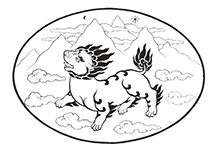
Additionally, we have over two dozen articles from the Snow Lion newsletter archive that are Drikung Kagyu specific. Please explore! Also check out our topic page on the Drikung Kagyu Tradition.
Another excellent resource is drikung.org, which contains information on many of the teachers and events in the Drikung Kagyu tradition, including the 800th parinirvana anniversary celebration of Jigten Sumgön, which will be held in October 2017 in Dehra Dun, India, and will be presided over by His Holiness Chetsang Rinpoche.
SNOW LION NEWSLETTER ARCHIVE
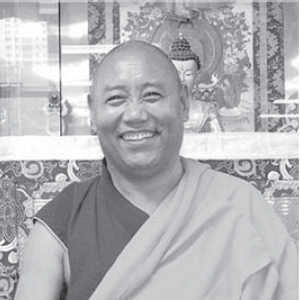
Khenchen Konchog Gyaltsen on How to Purify Obscurations

by Khenchen Konchog Gyaltshen
OK, we haven’t exactly been angelic all our lives—and our “obscurations” are part of the cause. Buddhism prescribes certain steps to help purify our misdeeds. This clear description of those steps is adapted here from A Complete Guide to the Buddhist Path by Khenchen Konchog Gyaltshen.
Application of the following four powers is an essential technique to purify obscurations. The four powers are (1) remorse, (2) antidote, (3) resolution, and (4) refuge or reliance.
Remorse. We must recognize that the negative thoughts and karma we have created are of no genuine benefit. Looking at things in this way is called the power of remorse. Deluded by attachment, anger, and ignorance, we think that we are protecting ourselves or destroying our enemies, but actually we are only creating negativity. However, at the time of death we will see clearly just how little benefit there was in attachment to ourselves and our relatives. The negative karma we created will follow us like a shadow and be a source of suffering lifetime after lifetime. Our activities may have resulted in some superficial benefit, but the negative karma we created is so much greater in comparison.
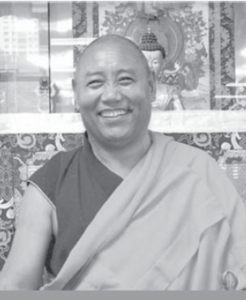
Remorse is not guilt. Rather, it is a recognition of the delusion that has caused us to exert so much effort without bringing happiness. It is like becoming aware that you have fallen into a filthy swamp. You feel embarrassed and urgently wish to wash as soon as possible to be free of the dirt. These teachings are based on reason, not mere “say-so.” So contemplate this well: despite the sacrifices we have made, we are left without much benefit in the long run.
Purification can be practiced through application of any one of the four powers, but it is more effective with all four together. But remorse is most important because, without it, the others are unlikely to arise. We should develop clear understanding that all deluded actions are unnecessary and are subject to purification, and that purification should be done as quickly as possible. For example, if someone has unwittingly taken poison, that individual will experience great remorse when he learns of his mistake. This will lead him to take urgent action to rid himself of the poison. Likewise, we should regard negative karma, even very small actions, as deadly poison.
Antidote. The power of antidote comes next. A feeling of remorse alone is not enough. Purification is incomplete if we only recognize the poison; we must act to get rid of it. This is like actually getting into the shower and washing the filth away. We must use all the methods we can to purify our obscurations—practice, meditation, and mantra recitation. What can we do? We can utilize many different Dharma practice techniques as an antidote to counteract the poison that causes suffering. For example, we can do Vajrasattva’s practice, recite Chenrezig’s mantra, or do Tara’s practice. We can cultivate loving-kindness and compassion and practice bodhicitta and emptiness.
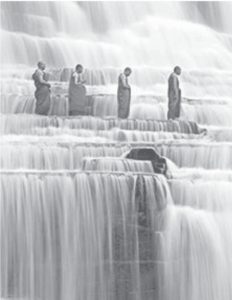
Resolve. Having applied these methods of purification, we then resolve never to repeat our negative thoughts and actions again. Once the poison has been removed, we must be cautious not to take it again. Similarly, we resolve to watch our step so that we do not fall into a swamp again. Now that we know these negative karmas are unnecessary and only bring suffering, we pledge, “Even at the risk of my life, I will never commit this fault again. In the past, I did this without awareness and meaninglessly. Now and in the future, I will not act this way again.”
Reliance. The fourth power is reliance on the Buddha, Dharma, and Sangha. Reliance is taking refuge, relying on the enlightened beings and on bodhicitta. It is thinking, “Right now, I have no ability to free myself from all obscurations.” So we have to rely on a good chef to prepare food that is not poisonous or on a dependable guide who will show us a path where we will not stumble. It is very important that we understand that every sentient being has buddha nature, for with this knowledge, we gain the confidence that “We, too, have the potential to attain buddhahood.” We can say with conviction, “If I practice the Dharma, enlightenment is genuinely possible just as it was for the buddhas of the past.” Once they were deluded beings like us, but they applied all their energy to studying and practicing the precious Dharma until they attained buddhahood which is free from suffering and its cause. So we too can rely on the antidotes with complete confidence that purification, and eventually enlightenment, will take place. For example, a farmer cultivates the field to grow his crops. He plows the ground, makes the ground soft, applies the fertilizer, moistens the soil, plants the seed, and protects it well until it is fully harvested. In the same way, we should cultivate our Dharma practice.
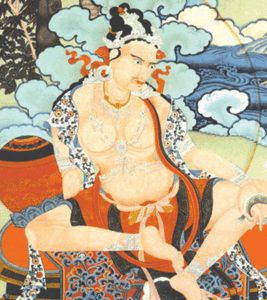
 One year, as the seventh month of the Tibetan calendar was drawing to a close, he was staying in solitude at Chuwar at Drok Menlung when a plague befell the people, killing many humans and animals. On the eleventh day of the following month, as the sun set, a young woman wearing pearl and turquoise ornaments and silken robes appeared, radiating light. In her hands were a pair of white silken cloths decorated in scarlet with designs resembling flames, surrounded by the five jewels. Touching her head to Mila’s feet, she circumambulated him seven times and prostrated nine times, saying, “Oh great Jetsün, our leader is gravely ill. Please come to that snow mountain.” And she pointed in a far direction. Great Jetsün replied, “The day is now well advanced, so I can’t leave. I will come when the sun rises.” The woman said, “A miraculous path of light will appear that will allow Jetsün to proceed to the snow mountain without obstacles. Therefore, please come today.” Great Jetsün said, “Let me see that path. I am an old man, but I have never heard of such a thing. In what direction does it lie? Point it out to me.” The woman pulled a bolt of white wool from her body and threw it across the sky to make a bridge, saying, “Please use this path.” No sooner had Jetsün set foot on the cloth than he arrived, like a flash of lightning, on the right side of the peak of the High Floating Queen of Snow Mountains [Gawishankar]. On that spot stood a white silk tent in which hung a piece of gold cotton cloth held up by a sapphire-like jewel. A standing shell served as the tent post, and the pegs were made of coral. On a couch lay a lady fine in every respect, her hair falling to her feet. Lifting her head and looking at Great Jetsün from blood-shot eyes, she said, “I am gravely ill; please heal me.” Jetsün asked, “What has caused your sickness and when did it start? How serious is it?” In this way he learned what had happened. “My illness was caused by unhealthful smoke that rose up when humans burned impure objects during these last summer months,” she replied. “It became especially severe from the twenty-sixth day of the eighth month. Therefore, I requested that you come here. My infected breath has afflicted all the people of that country and they have now fallen prey to various plagues.” Great Jetsün thought: “This is how so many people and animals died in that country. I must make this being enter into a commitment.” Aloud he said, “Beautiful lady, I previously gave you the Bodhisattva vow and the recitation mantra of the yidam. I have also given you the teachings on cause and effect. But you have not remained true to your samaya vows, for you have no patience even with a small sickness. You have caused much harm to many lives—even to beings who are blameless. Now, it is hard for me to trust you when I see what you have done. If you promise to stop bringing disease on other beings, I will see if I can help you. But if you do not promise, I will immediately leave, and you will continue to experience suffering because of your broken vows.” The woman became fearful and clung to the feet of the Jetsün, saying, “It is the nature of us ignorant beings to commit errors, so please do not be angry with us. In general, the higher gods will not harm others if others do not harm them. In particular, I have not harmed anyone because of my vows to you, Jetsün. This sickness arose naturally because I became ill. Just as the swelling of the streams in summer causes the ground all around to become damp, so the attendants who surrounded me—meat eaters and rakshas—harmed others. If I should become well, all those around me will also keep their word to you. By this action, the diseases will disappear of themselves. This once, please show your compassion.” Mila said, “Perform the purification of the hundred-syllable mantra, invoke the Triple Gem repeatedly, and perform the Ushnishavijaya practice to extend life.” Next day the woman was able to arise from her bed and do prostrations; after eight days she returned to a fully normal state, and her complexion became more radiant than before. Great Jetsün said, “Beautiful lady, since you have recovered your health, I will return to the people below to benefit them. Tell me which are the right materials for beings to burn so you do not fall ill again. What kind of prayers should they say?” She replied, “According to the samaya of the Loka Dakinis, if one among us is ill, all will fall ill. In addition, the gods and demons in samsara will also be affected. This is because of interdependent origination. In the same way, when I am well so are the others. But that they might return to health more quickly, they should recite the mantra of the essence of Tathagata’s ushnisha, read the profound Mahayana sutras, and bathe in the vase water. They should also create a boundary around the city and make torma and tshok offerings mixed with butter, cheese and sugar, with adornments of other foods. This will stop the various sicknesses.”
One year, as the seventh month of the Tibetan calendar was drawing to a close, he was staying in solitude at Chuwar at Drok Menlung when a plague befell the people, killing many humans and animals. On the eleventh day of the following month, as the sun set, a young woman wearing pearl and turquoise ornaments and silken robes appeared, radiating light. In her hands were a pair of white silken cloths decorated in scarlet with designs resembling flames, surrounded by the five jewels. Touching her head to Mila’s feet, she circumambulated him seven times and prostrated nine times, saying, “Oh great Jetsün, our leader is gravely ill. Please come to that snow mountain.” And she pointed in a far direction. Great Jetsün replied, “The day is now well advanced, so I can’t leave. I will come when the sun rises.” The woman said, “A miraculous path of light will appear that will allow Jetsün to proceed to the snow mountain without obstacles. Therefore, please come today.” Great Jetsün said, “Let me see that path. I am an old man, but I have never heard of such a thing. In what direction does it lie? Point it out to me.” The woman pulled a bolt of white wool from her body and threw it across the sky to make a bridge, saying, “Please use this path.” No sooner had Jetsün set foot on the cloth than he arrived, like a flash of lightning, on the right side of the peak of the High Floating Queen of Snow Mountains [Gawishankar]. On that spot stood a white silk tent in which hung a piece of gold cotton cloth held up by a sapphire-like jewel. A standing shell served as the tent post, and the pegs were made of coral. On a couch lay a lady fine in every respect, her hair falling to her feet. Lifting her head and looking at Great Jetsün from blood-shot eyes, she said, “I am gravely ill; please heal me.” Jetsün asked, “What has caused your sickness and when did it start? How serious is it?” In this way he learned what had happened. “My illness was caused by unhealthful smoke that rose up when humans burned impure objects during these last summer months,” she replied. “It became especially severe from the twenty-sixth day of the eighth month. Therefore, I requested that you come here. My infected breath has afflicted all the people of that country and they have now fallen prey to various plagues.” Great Jetsün thought: “This is how so many people and animals died in that country. I must make this being enter into a commitment.” Aloud he said, “Beautiful lady, I previously gave you the Bodhisattva vow and the recitation mantra of the yidam. I have also given you the teachings on cause and effect. But you have not remained true to your samaya vows, for you have no patience even with a small sickness. You have caused much harm to many lives—even to beings who are blameless. Now, it is hard for me to trust you when I see what you have done. If you promise to stop bringing disease on other beings, I will see if I can help you. But if you do not promise, I will immediately leave, and you will continue to experience suffering because of your broken vows.” The woman became fearful and clung to the feet of the Jetsün, saying, “It is the nature of us ignorant beings to commit errors, so please do not be angry with us. In general, the higher gods will not harm others if others do not harm them. In particular, I have not harmed anyone because of my vows to you, Jetsün. This sickness arose naturally because I became ill. Just as the swelling of the streams in summer causes the ground all around to become damp, so the attendants who surrounded me—meat eaters and rakshas—harmed others. If I should become well, all those around me will also keep their word to you. By this action, the diseases will disappear of themselves. This once, please show your compassion.” Mila said, “Perform the purification of the hundred-syllable mantra, invoke the Triple Gem repeatedly, and perform the Ushnishavijaya practice to extend life.” Next day the woman was able to arise from her bed and do prostrations; after eight days she returned to a fully normal state, and her complexion became more radiant than before. Great Jetsün said, “Beautiful lady, since you have recovered your health, I will return to the people below to benefit them. Tell me which are the right materials for beings to burn so you do not fall ill again. What kind of prayers should they say?” She replied, “According to the samaya of the Loka Dakinis, if one among us is ill, all will fall ill. In addition, the gods and demons in samsara will also be affected. This is because of interdependent origination. In the same way, when I am well so are the others. But that they might return to health more quickly, they should recite the mantra of the essence of Tathagata’s ushnisha, read the profound Mahayana sutras, and bathe in the vase water. They should also create a boundary around the city and make torma and tshok offerings mixed with butter, cheese and sugar, with adornments of other foods. This will stop the various sicknesses.”
Great Jetsün returned to the White Cliff of Drin and told the people, “I had a dream in which the leader of the Dakinis became displeased because of the smoke and steam from dirty cooking fires. For this reason, many gods and demons became angered. To pacify them, collect the materials to perform a tshok offering with many tormas. Invoke the Triple Gem, offer tormas to the Dharma protectors, share what you have assembled with the gods and demons of samsara, and pronounce the word of truth. In this way, the great plague will cease.”
On the twenty-ninth day of that month, Tashi Tseringma, along with five Dakinis of her retinue and other followers, approached Jetsün with many kinds of magnificent foods and drink placed in vessels made of four kinds of precious jewels. They also did prostrations, circumambulated him many times and sang songs to repay his kindness. They also requested the profound teachings which Great Jetsün offered in a song.
Once, while Mila was at Drin, Darmatak, one of his disciples, became lost, causing his relatives to mourn him. When the Lama asked about the cause of their lament, they replied, “Darmatak is surely dead.” The Lama replied, “He is not dead.” The relatives stopped crying and asked if the Lama could bring him back to them. Later, Darmatak reappeared, so proving that the Lama had perfect supernatural insight. In this way he possessed limitless qualities.
Milarepa was never separate from the samadhi state, experienced no duality between meditation and post meditation, and achieved the absolute truth of Dharmata, the manifestation of Dharmakaya.
On the eighth day of the fourth month in the Year of the Bird Mila entered Mahasamadhi at the age of eighty-two. His cremation took place both in Tise and Drin. At that time he appeared in three different places; in one form he became the object of offerings of Tashi Tseringma, and in another he went to India.
From The Great Kagyu Masters, translated by Khenpo Konchog Gyaltsen Rinpoche
$22.95 - Paperback
By: Khenchen Konchog Gyaltshen Rinpoche & Victoria Huckenpahler
$26.95 - Paperback
By: Jonathan C. Bell & Marie Aubele & Lama Kunsang & Maureen Lander & Lama Pemo
The Jewel Ornament of Liberation
The Jewel Ornament of Liberation
| The following article is from the Spring, 1998 issue of the Snow Lion Newsletter and is for historical reference only. You can see this in context of the original newsletter here. |
The Wish-fulfilling Gem of the Noble Teachings
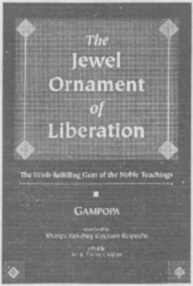
By Gampopa
Edited by Ani K. Trinlay Chodron
Foreword by H.H. the Fourteenth Dalai Lama
Translated by Khenchen Konchog Gyaltshen Rinpoche
The Jewel Ornament of Liberation is a master work of Tibetan Buddhism. For more than eight centuries, this text has provided a complete foundation for Buddhist study and practice beginning with how to enter the path, and continuing through to the achievement of Buddhahood. It includes teachings on Buddha-nature, finding the spiritual master, impermanence, karma, the cultivation of bodhicitta, the development of the six perfections, the ten bodhisattva bhumis, Buddhahood, and the activities of the Buddha.
Anyone who knows the Jewel Ornament well can say that they really understand Buddhism.
Gampopa(1074-1153 C.E.) was fully accomplished in the teachings and practice of Buddhism. He was the principal student of Milarepa and his teachings were clear like the sun. The Jewel Ornament of Liberation is the most significant of his many texts. Gampopa said, For anyone who wishes to see me, studying this [book] is the same as meeting me.
Venerable Khenpo Konchog Gyaltsen was born in Tsari, Tibet. After escaping from Chinese-controlled Tibet, he received his Acharya degree at the Central Institute of Higher Tibetan Studies at Varanasi, India a nine-year program. He then studied for years with highly realized masters of the different lineages. He did the traditional three-year retreat during which time he studied the Fivefold Profound Path of Mahamudra, the Six Yogas of Naropa and other teachings. In 1982, he came to the USA and established the Tibetan Meditation Center, now located in Frederick, Maryland. Since then he has devoted himself to establishing and teaching at various centers, writing and translating many texts.
Other books by Khenpo: Prayer Hags, Garland of Mahamudra Practices, In Search of the Stainless Ambrosia, The Great Kagyu Masters.
Following is an excerpt from The Jewel Ornament of Liberation titled Training in Aspiration Bodhicitta.
XII. Training. After cultivating bodhicitta, there are two types of training:
A. training in aspiration bodhicitta, and
B. in action bodhicitta.
A. Training in Aspiration Bodhicitta. The summary:
Not forsaking sentient beings from one's heart,
Recollecting the beneficial effects of that mind,
Gathering the two accumulations,
Practicing the enlightened mind repeatedly, and
Accepting the four virtues and rejecting the four nonvirtues
These five comprise the training in aspiration bodhicitta.
The first one is the method for not losing bodhicitta. The second one is the method by which bodhicitta does not weaken. The third one is the method for increasing the strength of bodhicitta. The fourth one is the method for deepening bodhicitta. The fifth one is the method for not forgetting bodhicitta.
1. Not Forsaking Sentient Beings from One's Heart. First, the training in not forsaking sentient beings from one's heart is the method for not losing bodhicitta. The Naga King Anavalapta-Requested Sutra says:
A bodhisattva who possesses one quality holds all the excellent qualities of the Buddhas. What is that one quality? A mind which does not forsake anyone from one's heart.
Suppose someone acts unfavorably toward you, and you adopt an attitude of distance from that person and have no concern for them. Even if there were a chance to help that person in the future, you would refuse to do it. Even if a time came to protect that person from harm, you would refuse to do it. That is called forsaking sentient beings.
Furthermore, what is meant by forsaking sentient beings? Does it mean all sentient beings or just one? Even Hearers or Solitary Realizers will not forsake all sentient beings, neither will the hawk and wolf. Therefore. if one forsakes even one being and does not apply the antidote within a session,1 then bodhicitta is lost. It is completely unreasonable to forsake sentient beings from your heart while being called a bodhisattva and maintaining other training. For example, this is like killing one's only child and then accumulating wealth on his behalf.
Of course one will not give up this attitude toward those beings who are benefitting oneself, but there is a danger of giving it up regarding those who harm you. To them especially, one should cultivate compassion and make efforts to bring them benefit and happiness. This is the tradition of the Noble Ones. It is said:
When harm has been done in return for good deeds,
Even then it is to be answered by great compassion.
The excellent beings of this world
Return a good deed for an evil one.
2. Recollecting the Beneficial Effects of Bodhicitta. Second, the training in recollecting the beneficial effects of bodhicitta is the method by which bodhicitta cannot weaken. The Lamp for the Path to Enlightenment says:
The quality of cultivating
The mind of aspiration
Was explained by Maitreya
In the Planting the Noble Stalk Sutra.
Thus it. says, and so forth.
In that sutra [the Planting the Noble Stalk Sutra], the beneficial effects of bodhicitta are illustrated through about 230 similes. All these beneficial effects are abbreviated as four categories.
Thus: O one of noble family! Bodhicitta is like the seed of all the Buddhas' qualities, and it dispels all poverty like Vaisravana, and so forth refer to the beneficial effects for oneself.
It fully protects all migrators like a shelter, and it supports all sentient beings so it is like ground, and so forth refer to its beneficial effects for others.
Because it is victorious over all the enemies of afflicting emotions, it is like a spear, and it completely cuts the tree of suffering like an axe, and so forth refer to its beneficial effect of cutting off all the unfavorable conditions.
It accomplishes all aspirations like the noble vase,and it accomplishes all wishes like the precious, wish-granting jewel, and so forth refer to its beneficial effect of establishing all the favorable conditions.
In this way when one recollects all these virtues, one will cherish this precious bodhicitta highly. In this way when one practices, one sustains this mind without weakening. Therefore, one should persistently recollect all these beneficial effects; at least, one should recollect them once every session.
3. Gathering the Two Accumulations. Third, the training in gathering the two accumulations is the method for increasing the strength of bodhicitla. The Lamp for the Path to Enlightenment says:
The accumulation of merit and wisdom
Is the nature of the cause of perfection. And so forth.
The accumulation of merit refers to the ten virtuous activities, the four methods of gathering, and so forth, as related to skillful methods. The accumulation of primordial wisdom refers to these practices realized as being fully free from the three spheres and so forth, as relates to the perfect wisdom. In this way, gathering the two accumulations establishes the power of bodhicitta in one's mind. Therefore, persistently gather the two accumulations; even by reciting one short mantra one can gather the two accumulations, so this should be done at least once each session. The Speech to an Assembly says:
Today, how should I accumulate
Merit and wisdom?
How can I benefit sentient beings?
Bodhisattvas constantly contemplate in this way.
4. Practicing the Enlightened Mind. Fourth, practicing the enlightened mind repeatedly is the method for deepening bodhicitta. The Lamp for the Path to Enlightenment says:
After developing aspiration bodhicitta,
One should make a great effort to deepen it.
In this, there are three topics: practicing the mind of the cause of enlightenment, practicing the mind of actual enlightenment, and practicing the mind of the action of enlightenment. Practicing these three deepens bodhicitta.
For the first, persistently develop loving-kindness and compassion toward all beings at least once each session.
The practice of actual enlightenment is the desire to obtain enlightenment for the benefit of sentient beings. Contemplate this three times in the daytime and three times at night. Use the detailed ceremony for cultivation of bodhicitta or at least repeat the following once each session:
I take refuge in the Buddha, the Dharma, and the Sangha until I achieve enlightenment. By the merit of generosity and other good deeds, may I attain enlightenment for the benefit of all beings.
There are two subdivisions in the mind of the action of enlightenment: practicing the attitude of benefitting others and practicing purification of one's own mind. First, cultivate the mind to dedicate and give your body, wealth, and all the virtues of the three times for others' benefit and happiness. Second, practice purifying your own mind. Always watch your moral ethics and abstain from evil deeds and afflictive emotions.
5. Rejection of the Four Unwholesome Deeds and Acceptance of the Four Wholesome Deeds. Fifth, training in rejection of the four unwholesome deeds and acceptance of the four wholesome deeds is the method of not forgetting bodhicitta. The Lamp for the Path to Enlightenment says:
One should fully protect the training as it is explained
In older to recollect this bodhicitta even in other lifetimes.
Where is this training explained? The Kashyapa-Requested Sutra says:
The four unwholesome deeds are stated. Kashyapa, the bodhi-sattva who possesses four qualities will forget bodhicitta. What are these four? These are: and so forth. Abbreviated, these are: deceiving the lama and those wort hy of worship; causing remorse in others when remorse is not appropriate; through aversion, saying improper words about a bodhisattva who has cultivated bodhicitta; and behaving deceitfully toward sentient beings.
The four wholesome deeds are also explained this way:
Kashyapa, the bodhisattva who possesses four qualities will remember bodhicitta immediat ely upon birth in all other lifetimes until he obtains the heart of enlightenment. Which are these four? These are: and so forth. Abbreviated, these are: not telling lies consciously even at the risk of one's own life; generally establishing all sentient beings in virtue, particularly in the virtues of the Mahayana; seeing bodhisattvas who have cultivated bodhicitta as Buddhas and proclaiming their qualities in all the ten directions; and sincerely maintaining the altruistic attitude toward all sentient beings.
Explanation of the first unwholesome deed.When one deceives the spiritual master, abbot, master, or one worthy of offerings by telling a lie with an insincere mind, your bodhicitta is lost if the antidote is not applied within a session whether they are aware of the lie or not, whether they are pleased or not, whether it is big or not, or whether they are deceived or not. The first wholesome deed is its antidote. Desist from consciously telling lies, even at the risk of your life.
Explanation of the second unwholesome deed. When someone performs virtuous deeds and you intend to make them regret it, your bodhicitta is lost if the antidote is not applied within a session whether they actually feel remorse or not. The second wholesome deed is its antidote. Establish all sentient beings in virtue, particularly in the virtues of the Mahayana. (Note: Chen-ngawa and Chayulwa specified virtuous Mahayana actions. Gyayondak said either Mahayana or Hinayana actions. Take, for example, the practice of generosity. The way of giving is virtuous, but if you get hungry tomorrow and have to go begging and so forth this can cause regret.)
Explanation of the third unwholesome deed. When, with hatred, you use improper words with a person who has cultivated bodhicitta, bodhicitta is lost if the antidote is not applied within a session whether you expressed ordinary faults or faults of the Dhanna, whether directly or indirectly, whether specific or not, whether gently or harshly, whether they heard it or not, or whether they were pleased or not. The third wholesome deed is its antidote. See bodhisattvas who have cultivated bodhicitta as Buddhas and make efforts to proclaim their virtues in all the ten directions.
Explanation of the fourth unwholesome deed. When, with deceit, you commit fraud toward any sentient being, bodhicitta is lost if the antidote is not applied within a session whether he was aware of it or not or whether it caused harm or not. The fourth wholesome deed is its antidote. Maintain the altruistic attitude toward all sentient beings and wish to benefit others without considering your own profit.
Related Books from the Kagyu Tradition
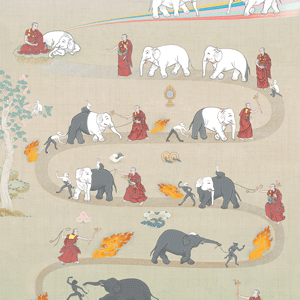
| The following article is from the Spring, 1989 issue of the Snow Lion Newsletter and is for historical reference only. You can see this in context of the original newsletter here. |
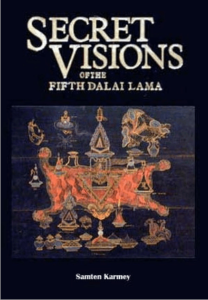
SECRET VISIONS OF THE FIFTH DALAI LAMA
by Samten Darmay
Serindia Publications, London
For centuries Tibet has served the planet as a nation dedicated to spiritual art, literature and practice. In an era when Europe was busy sending its armies around the world to pillage, rape and colonize, Tibet was engaged in studying, cataloging and eulogizing the stages of enlightenment and the varieties of mystical experience. Its GNP was not measured in materialistic terms alone, but in the number of yogis and sages that blossomed forth from within its precincts.
Thus when in 1642 the saintly Fifth Dalai Lama rose to become both spiritual and secular chieftain of the Tibetan nation, echoes of a destiny fulfilled rang throughout the mountains and valleys of Central Asia.
The Fifth Dalai Lama (1617-1682) stands as perhaps the singularly most striking figure in Tibetan history. He was one of those rare men who seem bigger than life itself, a superman who accomplished in one short lifetime the deeds of a thousand ordinary heroes. From the literary viewpoint he was colossal, writing as much as all other Dalai Lamas put together. As a builder he left us with numerous marvels that can compare with the world's greatest architectural achievements, the Potala of Lhasa being perhaps the most well-known of these. His poetry is considered by Asian intellectuals to be among the most inspired verse ever composed in the Tibetan language; and his reputation as a philosopher, historian, artist, doctor and teacher far exceeds that of anyone else of the period. Moreover, he was not some mere artist, intellectual or mystic; his work as a statesman laid the very foundations for the emergence of Classical Tibet, the Tibet that rapidly came to serve as the cultural grandparent to all Central Asia.
Yet he did not accomplish all this without giving rise to some controversy. In the fulfillment of his dreams and ideals, much of the old and stagnant had to be swept aside in order to make way for the new; and although he was a man of great compassion, he was never one to hesitate on the borders of apathetic sentimentalism. His gentleness in no way rendered him indecisive or impotent, and in sculpting his image of a new Tibet he did not fear to strike with the political artist's chisel wherever and whenever it seemed appropriate.
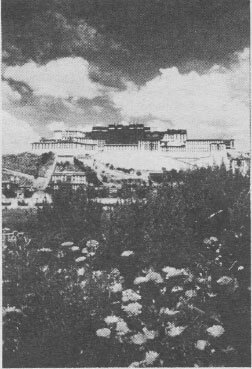
The COLLECTED WORKS of the Fifth Dalai Lama is comprised of twenty-eight bundles of texts, and contains more than a thousand titles. These twenty-eight are divided into three categories Outer, Inner, and Secret with twelve bundles in the first of these categories, eight in the second and eight more in the third. As His Holiness the Dalai Lama points out in his Foreword to the volume under review, traditionally only the first two categories of works were ever printed in Tibet. Generally the texts in the Secret category were only available to high initiates, and were not allowed to be mass-produced or openly marketed; anyone wanting a text in this category would have to request special permission to have a hand-copy made.
Secret Visions of the Fifth Dalai Lama by Samten Karmay is a study of one of these eight Secret Volumes. The Tibetan text of the volume contains sixteen individual titles, the first of these being the Fifth Dalai Lama's catalog of the numerous visions that he experienced during his life.
The edition by Serindia Publications is remarkable in that it is based upon an original and priceless manuscript prepared during the lifetime of the Great Fifth Dalai Lama himself, with hundreds of exquisite color illustrations executed under the Fifth's direct supervision. The Serindia edition, as well as carrying high-quality reproductions of all the illustrations, contains a reducted photographic reprint of the entire Tibetan manuscript. Thus as well as being an excellent work on classical seventeenth century Tibetan art, it is a valuable addition to the library of any Tibetan scholar.
Samten Karmay's contribution is his brief Summary of the contents of the Tibetan texts, and an Introduction that provides the reader with a general picture of Tibetan history and the Fifth Dalai Lama's life.
Although his Summary deals with all sixteen Tibetan texts, the bulk of his commentary focuses on the first of these, Secret Visions itself. The remaining fifteen texts-ritual and liturgical works mainly of an exorcistic nature are given only a paragraph or two each.
A disappointing feature of the Summary is that Mr. Karmay satisfies himself with merely listing the various 'beings' (gurus, buddhas, bodhisattvas, tantric deities, etc.) whom the Fifth saw in his visions, and does not deal with any of the prophetic (and highly poetic) conversations that ensued, nor with the meaning or significance of the visions. By cutting the material to a mere skeleton of events, we are left with something that reads almost like a list or diary of daily appointments. However, it may be argued that for him to attempt to take the material further would have opened a whole other dimension to the work, and would have expanded the volume prohibitively.
Secret Visions of the Fifth Dalai Lama is an elegant and enticing edition. Undoubtedly it is a valuable contribution to our understanding of the complex character of the Fifth Dalai lama, and to the many facets of his personality. It could stand as a landmark work merely on the strength of its artwork, just as it could for the Tibetan texts that it contains, it is the type of publication that does not need to be read to be admired and appreciated; merely holding it and letting one's eyes flow over its pages suffices to bestow upon the beholder the sense of being in the presence of beauty, greatness, the mystical and the very sublime.
-Glenn H. Mullin
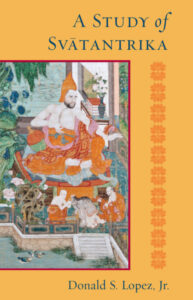
A STUDY OF SVATANTRIKA
by Donald S. Lopez
Snow Lion Publications, Ithaca, NY
In this book, Lopez presents a translation and study which brings to light the seventeenth-eighteenth-century Tibetan Buddhist scholar, Jang-gya's views on the Svatantrika-Madhyamaka school of Indian Mahayana Buddhism. The work translated by Lopez is, in effect, one chapter from the larger work by Jang-gya expounding the views of the various Indian Buddhist and non-Buddhist schools. Jang-gya's interpretations are based primarily on those of the great Gelugpa founder, Tsongkhapa as found in his own compositions and as interpreted by later tradition. In preparing this work, Lopez has consulted with a number of contemporary scholars who provided oral commentary on Jang-gya's composition. Lopez's excellent introduction and commentary set Jang-gya's work within its larger Indian and Tibetan context and place Lopez' own study within the tradition of Western Buddhology. This work has been produced with care and integrity and makes an important contribution to our knowledge of Svatantrika.
Reginald Ray for Religious Studies Review
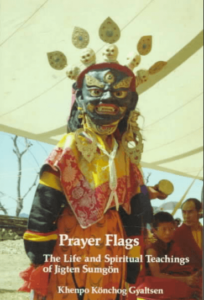
PRAYER FLAGS-THE LIFE AND SPIRITUAL TEACHINGS OF JIGTEN SUMGON
by Khenpo Konchog Gyaltsen
Snow Lion Publications, Ithaca, NY
Jigten Sumgon was the founder of the Drikung Kagyu, a subschool of the Kagyu tradition, one of the four great lineages of Tibetan Buddhism, and which originated in Tibet with Marpa the translator, whose teachers included the great Indian pandit Naropa. Marpa's most illustrious disciple was Jetsun Milarepa, a legend in Tibet. He in turn taught Gampopa who had also imbibed the Kadam tradition from the Indian pandit Atisa. From Gampopa came the four elder lineages of the Kagyu and from one of these the Phagdru Kagyu, founded by Phagmo Drupacame the eight younger lineages (such as the Karma Kagyu, etc.). Of these eight one was the Drikung Kagyu and the subject of this book.
The initiator and translator of this book is the Abbot Konchog Gyaltsen, a scholar and meditator in the Drikung tradition. As well as translating the life of Jigten Sumgon, he has included the biographies of Gampopa and Phagmo drupaJigten Sumgon's main teacher. The second half of the book contains a selection of Jigten Sumgon's Vajra songs and a brief exposition of the Fivefold Profound Path of Mahamudra, the main philosophy and practice of the Kagyu tradition.
Like most Tibetan biographies, this one is replete with miracles and mysterious happenings which accompany the events surrounding the subject's life. During one discourse Jigten Sumgon actually stopped the sun from sinking so that he could finish his teachings. His visions and his ability to communicate with other realms are astonishing. His songs are terse, profound and reverberate with typical Mahamudra themes such as non-duality and non-effort, subjects very open to misinterpretation by the uninitiated. Likewise, the section on Mahamudra philosophy and practice is brief and to the point, going straight to the nature of reality and of the mind. All this is in keeping with the Kagyu emphasis on practice and intense meditation. A three-year uninterrupted meditational retreat is standard practice for a Kagyupa (a devotion which the translator has successfully performed).
The translator states that he has brought this book out for the many Westerners interested in Buddhism, 'to kindle the flame of their understanding'. Followers of the Kagyu tradition will obviously revere this book and others whose dispositions incline them towards the kind of approach Mahamudra offers will likewise be inspired. Presumably the translator chose these texts in order to give his readers a taste of the practice and practitioners of the Drikung Kagyu lineage. They are certainly fascinating enough to inspire the interested reader to search out more information on this noble tradition.Gavin Kilty, Buddhist Studies Review.
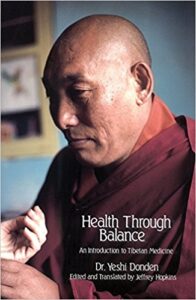
HEALTH THROUGH BALANCE
by Dr. Donden
Snow Lion Publications
Health Through Balance offers a fresh and insightful perspective on American eating habits as seen from the viewpoint of a Tibetan physician. The information on traditional food preparation and storage is immensely valuable. His food categorization is based on the Tibetan four-element system. Dr. Donden presents an expanded view of disease as precipitated primarily from our own behavior. Health Through Balance is a theoretical and inspirational book that offers a grand overview and some practical information.
Journal of Traditional Acupuncture
Related Books

